Advances in High–Speed, High–Power Photodiodes: From Fundamentals to Applications
Abstract
:1. Introduction
2. Overall Design Considerations for Photodiodes
2.1. Principles of PIN–PD and UTC–PD
2.2. 3–dB Bandwidth Analysis and Discussion
2.3. Equivalent Circuit Models
2.4. Saturation Current and Output Power
3. Solutions of Bandwidth–Responsivity Trade–Off
3.1. High–Reflected Mirrors for Photodiodes
3.2. Microhole Design for Photodiodes
3.3. High–Reflected Mirrors for Group–IV Photodiodes
4. Photodiode Photonic–Integrated Applications
4.1. Photodiodes Integrated with Short–Stubs
4.2. Photodiodes Integrated with Antennas

5. Discussion
6. Conclusions
Author Contributions
Funding
Institutional Review Board Statement
Informed Consent Statement
Data Availability Statement
Conflicts of Interest
References
- Giordani, M.; Polese, M.; Mezzavilla, M.; Rangan, S.; Zorzi, M. Toward 6G Networks: Use Cases and Technologies. IEEE Commun. Mag. 2020, 58, 55–61. [Google Scholar] [CrossRef]
- Rajatheva, N.; Atzeni, I.; Bjornson, E.; Bourdoux, A.; Buzzi, S.; Dore, J.-B.; Erkucuk, S.; Fuentes, M.; Guan, K.; Hu, Y.; et al. White Paper on Broadband Connectivity in 6G. arXiv 2020, arXiv:2004.14247. [Google Scholar]
- Xiaohu, Y.; Cheng-xiang, W.; Jie, H.; Xiqi, G.; Michael, W.; Yongming, H.; Chuan, Z.; Yanxiang, J.; Min, Z.; Dongming, W.; et al. Towards 6G Wireless Communication Networks: Vision, Enabling Technologies, and New Paradigm Shifts. Sci. China Inf. Sci. 2020, 64, 110301. [Google Scholar]
- Koenig, S.; Lopez-Diaz, D.; Antes, J.; Boes, F.; Henneberger, R.; Leuther, A.; Tessmann, A.; Schmogrow, R.; Hillerkuss, D.; Palmer, R.; et al. Wireless Sub-THz Communication System with High Data Rate. Nat. Photonics 2013, 7, 977–981. [Google Scholar] [CrossRef]
- Nagatsuma, T.; Ito, H.; Ishibashi, T. High-Power RF Photodiodes and Their Applications. Laser Photonics Rev. 2009, 3, 123–137. [Google Scholar] [CrossRef]
- Renaud, C.C.; Natrella, M.; Graham, C.; Seddon, J.; Van Dijk, F.; Seeds, A.J. Antenna Integrated THz Uni-Traveling Carrier Photodiodes. IEEE J. Sel. Top. Quantum Electron. 2018, 24, 8500111. [Google Scholar] [CrossRef]
- Wakatsuki, A.; Muramoto, Y.; Ishibashi, T. Development of Terahertz-Wave Photomixer Module Using a Uni-Traveling-Carrier Photodiode. NTT Tech. Rev. 2012, 10, 1–7. [Google Scholar]
- Seeds, A.J.; Shams, H.; Fice, M.J.; Renaud, C.C. TeraHertz Photonics for Wireless Communications. J. Light. Technol. 2015, 33, 579–587. [Google Scholar] [CrossRef]
- Nagatsuma, T.; Ducournau, G.; Renaud, C.C. Advances in Terahertz Communications Accelerated by Photonics. Nat. Photonics 2016, 10, 371–379. [Google Scholar] [CrossRef]
- ITU. International Telecommunication Union ITU-R P.840-3: Attenuation Due to Clouds and Fog; ITU: Geneva, Switzerland, 1999. [Google Scholar]
- ITU. International Telecommunication Union ITU-R P.676-6: Attenuation by Atmospheric Gases; ITU: Geneva, Switzerland, 2005.
- Han, S.; Chih-Lin, I.; Xu, Z.; Rowell, C. Large-Scale Antenna Systems with Hybrid Analog and Digital Beamforming for Millimeter Wave 5G. IEEE Commun. Mag. 2015, 53, 186–194. [Google Scholar] [CrossRef]
- Omam, Z.R.; Abdel-wahab, W.M.; Gigoyan, S.; Safavi-naeini, S. High Gain 4 × 4 SIW Passive Phased Array Antenna. In Proceedings of the 2020 IEEE International Symposium on Antennas and Propagation and North American Radio Science Meeting, Toronto, ON, Canada, 5–10 July 2020; pp. 45–46. [Google Scholar]
- Nagarajan, R.; Member, S.; Joyner, C.H.; Schneider, R.P.; Bostak, J.S.; Butrie, T.; Dentai, A.G.; Dominic, V.G.; Evans, P.W.; Kato, M.; et al. Large-Scale Photonic Integrated Circuits. IEEE J. Sel. Top. Quantum Electron. Electron. 2005, 11, 50–65. [Google Scholar] [CrossRef]
- Song, H.J.; Nagatsuma, T. Present and Future of Terahertz Communications. IEEE Trans. Terahertz Sci. Technol. 2011, 1, 256–263. [Google Scholar] [CrossRef]
- Harter, T.; Ummethala, S.; Blaicher, M.; Muehlbrandt, S.; Wolf, S.; Weber, M.; Adib, M.M.H.; Kemal, J.N.; Merboldt, M.; Boes, F.; et al. Wireless THz Link with Optoelectronic Transmitter and Receiver. Optica 2019, 6, 1063–1070. [Google Scholar] [CrossRef]
- Bowers, S.M.; Abiri, B.; Aflatouni, F.; Hajimiri, A. A Compact Optically Driven Travelling-Wave Radiating Source. In Proceedings of the Optical Fiber Communication Conference 2014, San Francisco, CA, USA, 9–13 March 2014; pp. 18–20. [Google Scholar]
- Shi, J.-W.; Kuo, F.-M.; Wu, Y.-S.; Chen, N.-W.; Shih, P.-T.; Lin, C.-T.; Jiang, W., Jr.; Wong, E.-Z.; Chen, J.; Chi, S. A W-Band Photonic Transmitter-Mixer Based on High-Power Near-Ballistic Uni-Traveling-Carrier Photodiodes for BPSK and QPSK Data Transmission Under Bias Modulation. IEEE Photonics Technol. Lett. 2009, 21, 1039–1041. [Google Scholar] [CrossRef]
- Costanzo, R.; Yang, Z.; Beling, A.; Bowers, S.M. Wideband Balanced Photoreceivers with InP-Based Photodiodes and 65 Nm CMOS TIAs for Use in Optical Frequency Synthesis Systems. J. Light. Technol. 2019, 37, 5833–5839. [Google Scholar] [CrossRef]
- Ferguson, B.; Zhang, X.-C. Materials for Terahertz Science and Technology. Nat. Mater. 2002, 1, 26–33. [Google Scholar] [CrossRef] [PubMed]
- Rouvalis, E.; Renaud, C.C.; Moodie, D.G.; Robertson, M.J.; Seeds, A.J. Traveling-Wave Uni-Traveling Carrier Photodiodes for Continuous Wave THz Generation. Opt. Express 2010, 18, 11105–11110. [Google Scholar] [CrossRef] [PubMed]
- Shen, X.; Morgan, J.; Costanzo, R.; Sun, K.; Woodson, M.; Estrella, S.B.; Beling, A.; Bowers, S.M. High-Power V-Band-to-G-Band Photonically Driven Electromagnetic Emitters. IEEE Trans. Microw. Theory Tech. 2021, 69, 1474–1487. [Google Scholar] [CrossRef]
- Sun, K.; Beling, A. High-Speed Photodetectors for Microwave Photonics. Appl. Sci. 2019, 9, 623. [Google Scholar] [CrossRef]
- Nagatsuma, T.; Horiguchi, S.; Minamikata, Y.; Yoshimizu, Y.; Hisatake, S.; Kuwano, S.; Yoshimoto, N.; Terada, J.; Takahashi, H. Terahertz Wireless Communications Based on Photonics Technologies. Opt. Express 2013, 21, 23736. [Google Scholar] [CrossRef]
- Sun, K.; Moody, J.; Li, Q.; Bowers, S.M.; Beling, A. High Power Integrated Photonic W-Band Emitter. IEEE Trans. Microw. Theory Tech. 2018, 66, 1668–1677. [Google Scholar] [CrossRef]
- Assefzadeh, M.M.; Babakhani, A. Broadband Oscillator-Free THz Pulse Generation and Radiation Based on Direct Digital-to-Impulse Architecture. IEEE J. Solid-State Circuits 2017, 52, 2905–2919. [Google Scholar] [CrossRef]
- Wang, C.; Lu, B.; Lin, C.; Chen, Q.; Miao, L.; Deng, X.; Zhang, J. 0.34-Thz Wireless Link Based on High-Order Modulation for Future Wireless Local Area Network Applications. IEEE Trans. Terahertz Sci. Technol. 2014, 4, 75–85. [Google Scholar] [CrossRef]
- Razavian, S.; Babakhani, A. A THz Pulse Radiator Based on PIN Diode Reverse Recovery. In Proceedings of the 2019 IEEE BiCMOS and Compound semiconductor Integrated Circuits and Technology Symposium (BCICTS), Nashville, TN, USA, 3–6 November 2019; IEEE: New York, NY, USA, 2019; pp. 1–4. [Google Scholar]
- Deng, J.; Burasa, P.; Wu, K. Joint Multiband Linear Interferometric Receiver for Integrated Microwave and Terahertz Sensing and Communication Systems. IEEE Trans. Microw. Theory Tech. 2024, 1–13. [Google Scholar] [CrossRef]
- Ueda, A.; Noguchi, T.; Iwashita, H.; Sekimoto, Y.; Ishiguro, M.; Takano, S.; Nagatsuma, T.; Ito, H.; Hirata, A.; Ishibashi, T. W-Band Waveguide Photomixer Using a Uni-Traveling-Carrier Photodiode with 2-MW Output. IEEE Trans. Microw. Theory Tech. 2003, 51, 1455–1459. [Google Scholar] [CrossRef]
- Ishibashi, T.; Shimizu, N.; Kodama, S.; ITO, H.; Nagatuma, T.; Furuta, T. Uni-Traveling-Carrier Photodiodes. In Proceedings of the Ultrafast Electronics and Optoelectronics 1997, Incline Village, NA, USA, 17–21 March 1997; pp. 83–87.
- Ishibashi, T.; Ito, H. Uni-Traveling-Carrier Photodiodes. J. Appl. Phys. 2020, 127, 031101. [Google Scholar] [CrossRef]
- Kishino, K.; Unlu, M.S.; Chyi, J.-I.; Reed, J.; Arsenault, L.; Morkoc, H. Resonant Cavity-Enhanced (RCE) Photodetectors. IEEE J. Quantum Electron. 1991, 27, 2025–2034. [Google Scholar] [CrossRef]
- Chen, Q.; Huang, Y.; Zhang, X.; Duan, X.; Fei, J.; Ma, X.; Liu, T.; Wu, G.; Liu, K.; Ren, X. Uni-Traveling-Carrier Photodetector with High-Reflectivity DBR Mirrors. IEEE Photonics Technol. Lett. 2017, 29, 1203–1206. [Google Scholar] [CrossRef]
- Chen, Q.; Fang, W.; Huang, Y.; Duan, X.; Liu, K.; Sharawi, M.S.; Ren, X. Uni-Traveling-Carrier Photodetector with High-Contrast Grating Focusing-Reflection Mirrors. Appl. Phys. Express 2020, 13, 016503. [Google Scholar] [CrossRef]
- Zhou, Q.; Cross, A.; Fu, Y.; Beling, A.; Campbell, J.C. High-Power High-Bandwidth Flip-Chip Bonded Modified Uni-Traveling Carrier Photodiodes. In Proceedings of the IEEE Photonics Conference 2012, Burlingame, CA, USA, 23–27 September 2012; IEEE: New York, NY, USA, 2012; Volume 2, pp. 306–307. [Google Scholar]
- Li, Z.; Fu, Y.; Piels, M.; Pan, H.; Beling, A.; Bowers, J.E.; Campbell, J.C. High-Power High-Linearity Flip-Chip Bonded Modified Uni-Traveling Carrier Photodiode. Opt. Express 2011, 19, B385–B390. [Google Scholar] [CrossRef]
- Xie, X.; Zhou, Q.; Li, K.; Shen, Y.; Li, Q.; Yang, Z.; Beling, A.; Campbell, J.C. Improved Power Conversion Efficiency in High-Performance Photodiodes by Flip-Chip Bonding on Diamond. Optica 2014, 1, 429–435. [Google Scholar] [CrossRef]
- Ito, H.; Shibata, N.; Nagatsuma, T.; Ishibashi, T. Terahertz-Wave Detector on Silicon Carbide Platform. Appl. Phys. Express 2022, 15, 026501. [Google Scholar] [CrossRef]
- Kashyap, R. Fiber Bragg Gratings, 2nd ed.; Academic Press: Cambridge, MA, USA, 2010. [Google Scholar]
- Chen, Q.; Boisvert, J.-S.; Sharawi, M.S.; Kashyap, R. Bragg Gratings with Novel Waveguide Models Fabricated in Bulk Glass via Fs-Laser Writing and Their Slow-Light Effects. Opt. Express 2024, 32, 188–204. [Google Scholar] [CrossRef]
- Bowers, J.; Burrus, C. Ultrawide-Band Long-Wavelength p-i-n Photodetectors. J. Light. Technol. 1987, 5, 1339–1350. [Google Scholar] [CrossRef]
- Kato, K. Ultrawide-Band/High-Frequency Photodetectors. IEEE Trans. Microw. Theory Tech. 1999, 47, 1265–1281. [Google Scholar] [CrossRef]
- Ishibashi, T.; Furuta, T.; Fushimi, H.; Kodama, S.; Ito, H.; Nagatsuma, T.; Shimizu, N.; Miyamoto, Y. InP/InGaAs Uni-Traveling-Carrier Photodiodes. IEICE Trans. Electron. 2000, E83-C, 938–949. [Google Scholar]
- Ishibashi, T.; Ito, H. Uni-Traveling Carrier Photodiodes: Development and Prospects. IEEE J. Sel. Top. Quantum Electron. 2022, 28, 3803006. [Google Scholar] [CrossRef]
- Kurishima, K.; Nakajima, H.; Kobayashi, T.; Ishibashi, T.; Matsuoka, Y. Fabrication and Characterization of High-Performance InP/InGaAs Double-Heterojunction Bipolar Transistors. IEEE Trans. Electron Devices 1994, 41, 1319–1326. [Google Scholar] [CrossRef]
- Li, N.; Li, X.; Demiguel, S.; Zheng, X.; Campbell, J.C.; Tulchinsky, D.A.; Williams, K.J.; Isshiki, T.D.; Kinsey, G.S.; Sudharsansan, R. High-Saturation-Current Charge-Compensated InGaAs–InP Uni-Traveling-Carrier Photodiode. IEEE Photonics Technol. Lett. 2004, 16, 864–866. [Google Scholar] [CrossRef]
- Wang, X.; Duan, N.; Chen, H.; Campbell, J.C. InGaAs–InP Photodiodes With High Responsivity and High Saturation Power. IEEE Photonics Technol. Lett. 2007, 19, 1272–1274. [Google Scholar] [CrossRef]
- Adachi, S. Refractive Indices of III-V Compounds: Key Properties of InGaAsP Relevant to Device Design. J. Appl. Phys. 1982, 53, 5863–5869. [Google Scholar] [CrossRef]
- Wang, H.; Mao, S. High Speed InP/InGaAs Uni-Traveling-Carrier Photodiodes with Dipole-Doped InGaAs/InP Absorber-Collector Interface. In Proceedings of the IPRM 2011—23rd International Conference on Indium Phosphide and Related Materials, Berlin, Germany, 22–26 May 2011; pp. 1–3. [Google Scholar]
- Meng, Q.Q.; Wang, H.; Liu, C.Y.; Ang, K.S.; Guo, X.; Gao, B.; Tian, Y.; Kumar, C.M.M.; Gao, J. High-Photocurrent and Wide-Bandwidth UTC Photodiodes with Dipole-Doped Structure. IEEE Photonics Technol. Lett. 2014, 26, 1952–1955. [Google Scholar] [CrossRef]
- Meng, Q.; Wang, H.; Liu, C.; Guo, X.; Gao, J.; Ang, K.S. High-Speed and High-Responsivity InP-Based Uni-Traveling-Carrier Photodiodes. IEEE J. Electron Devices Soc. 2017, 5, 40–44. [Google Scholar] [CrossRef]
- Kato, K.; Hata, S.; Kawano, K.; Kozen, A. Design of Ultrawide-Band, High-Sensitivity p–i–n-Photodetectors. IEICE Trans. Electron. 1993, E76-C, 214–221. [Google Scholar]
- Ito, H.; Kodama, S.; Muramoto, Y.; Furuta, T.; Nagatsuma, T.; Ishibashi, T. High-Speed and High-Output InP–InGaAs Unitraveling-Carrier Photodiodes. IEEE J. Sel. Top. Quantum Electron. 2004, 10, 709–727. [Google Scholar] [CrossRef]
- Bahl, I. Multilayer Dielectric Capacitor. In Lumped Elements for RF and Microwave Circuits; Artech House: London, UK, 2003; pp. 171–172. [Google Scholar]
- Liu, F.; Huang, Y.; Kang, C.; Chen, Q.; Duan, X.; Liu, K.; Wang, Q.; Zhang, X.; Wang, J.; Ren, X. Optimization of High Speed and High Saturation Uni-Traveling-Carrier Photodiode. In Proceedings of the Asia Communications and Photonics Conference (ACPC), Hong Kong, China, 19–23 November 2015; p. ASu2A.11. [Google Scholar]
- Wang, J.; Duan, X.; Huang, Y.; Liu, K.; Fei, J.; Chen, Q.; Ren, X. Novel 1.55 Μm Mushroom-Type Vertical-Illumination Photodiode. In Proceedings of the Asia Communications and Photonics Conference (ACPC), Wuhan, China, 2–5 November 2016; p. AF2A.68.2. [Google Scholar]
- Liu, F.; Huang, Y.; Kang, C.; Chen, Q.; Duan, X.; Ren, X. High Speed and High Responsivity Dual-Absorption InGaAs/InP UTC-PDs. In Proceedings of the Opto-Electronics and Communications Conference (OECC), Shanghai, China, 28 June–2 July 2015; pp. 1–3. [Google Scholar]
- Kang, C.; Huang, Y.; Liu, F.; Fei, J.; Chen, Q.; Liu, K.; Duan, X.; Wang, Q.; Wang, J.; Zhang, X.; et al. A Mushroom Dual-Absorption Partially Depleted Absorber Photodetector. In Proceedings of the Asia Communications and Photonics Conference, Hong Kong, China, 19–23 November 2015; p. ASu2A.1. [Google Scholar]
- Liu, L.; Huang, Y.; Ma, X.; Fei, J.; Chen, Q.; Liu, K.; Duan, X.; Ren, X. Study of the Effect of Gaussian Doping in Absorber on High Speed Performance of Uni-Traveling-Carrier Photodetector. In Proceedings of the Asia Communications and Photonics Conference (ACPC), Wuhan, China, 2–5 November 2016; p. AF3F.7. [Google Scholar]
- Chen, Q.; Huang, Y.; Duan, X.; Liu, F.; Kang, C.; Wang, Q.; Wang, J.; Zhang, X.; Ren, X. High-Speed Uni-Traveling-Carrier Photodetector with the New Design of Absorber and Collector. In Proceedings of the Opto-Electronics and Communications Conference (OECC), Shanghai, China, 28 June–2 July 2015; IEEE: New York, NY, USA, 2017. [Google Scholar]
- Chen, Q.-T.; Huang, Y.-Q.; Fei, J.-R.; Duan, X.-F.; Liu, K.; Liu, F.; Kang, C.; Wang, J.-C.; Fang, W.-J.; Ren, X.-M. Fabrication and Characterization of Novel High-Speed InGaAs/InP Uni-Traveling-Carrier Photodetector for High Responsivity. Chinese Phys. B 2015, 24, 108506. [Google Scholar] [CrossRef]
- Liu, T.; Huang, Y.; Chen, Q.; Fei, J.; Liu, K.; Duan, X.; Ren, X. Transient Simulation of UTC-PD Using Drift-Diffusion Model. In Proceedings of the International Conference on Numerical Simulation of Optoelectronic Devices (NUSOD), Copenhagen, Denmark, 24–28 July 2017; IEEE: New York, NY, USA, 2017; pp. 139–140. [Google Scholar]
- Ma, X.; Huang, Y.; Fei, J.; Chen, Q.; Liu, T.; Liu, K.; Duan, X.; Yan, X.; Ren, X. Analysis of Dark Current Considering Trap-Assisted Tunneling Mechanism for InGaAs PIN Photodetectors. Opt. Quantum Electron. 2017, 49, 407. [Google Scholar] [CrossRef]
- Ma, X.; Huang, Y.; Fei, J.; Chen, Q.; Liu, T.; Li, G.; Duan, X.; Liu, K.; Cai, S.; Ren, X. InP-Based Photodetectors with Wide Spectral Range and Low Dark Current for Optical Interconnection. In Proceedings of the Asia Communications and Photonics Conference (ACPC), Guangzhou, China, 10–13 November 2017; OSA: Washington, DC, USA, 2017; p. Su4K.6. [Google Scholar]
- Liu, T.; Huang, Y.; Fei, J.; Chen, Q.; Ma, X.; Duan, X.; Liu, K.; Ren, X. Influences of Contact Electrode Shape and Incidence Direction on P-i-n Photodiodes. IET Optoelectron. 2019, 13, 151–154. [Google Scholar] [CrossRef]
- Ito, H.; Furuta, T.; Kodama, S.; Ishibashi, T. InP/InGaAs Uni-Travelling-Carrier Photodiode with 310 GHz Bandwidth. Electron. Lett. 2000, 36, 1809–1810. [Google Scholar] [CrossRef]
- Fukano, H.; Muramoto, Y.; Takahata, K.; Matsuoka, Y. High Efficiency Edge-Illuminated Uni-Travelling-Carrier-Structure Refracting-Facet Photodiode. Electron. Lett. 1999, 35, 1664. [Google Scholar] [CrossRef]
- Ito, H.; Furuta, T.; Kodama, S.; Ishibashi, T. High-Efficiency Unitraveling-Carrier Photodiode with an Integrated Total-Reflection Mirror. J. Light. Technol. 2000, 18, 384–387. [Google Scholar] [CrossRef]
- Ito, H.; Furuta, T.; Kodama, S.; Watanabe, N.; Ishibashi, T. InP/InGaAs Uni-Travelling-Carrier Photodiode with 220 GHz Bandwidth. Electron. Lett. 1999, 35, 1556–1557. [Google Scholar] [CrossRef]
- Beling, A.; Campbell, J.C.; Pan, H.; Chen, H.; Bach, H.-G.; Mekonnen, G.G.; Schmidt, D. InP-Based High-Speed Photonic Devices. In Proceedings of the OFC/NFOEC 2008—2008 Conference on Optical Fiber Communication/National Fiber Optic Engineers Conference, San Diego, CA, USA, 24–28 February 2008; IEEE: New York, NY, USA, 2008; pp. 1–27. [Google Scholar]
- Ishibashi, T.; Muramoto, Y.; Yoshimatsu, T.; Ito, H. Unitraveling-Carrier Photodiodes for Terahertz Applications. IEEE J. Sel. Top. Quantum Electron. 2014, 20, 79–88. [Google Scholar] [CrossRef]
- Li, X.; Li, N.; Demiguel, S.; Zheng, X.; Campbell, J.C.; Tan, H.H.; Jagadish, C. A Partially Depleted Absorber Photodiode With Graded Doping Injection Regions. IEEE Photonics Technol. Lett. 2004, 16, 2326–2328. [Google Scholar] [CrossRef]
- Li, X.; Li, N.; Demiguel, S.; Campbell, J.C.; Tulchinsky, D.; Williams, K.J. A Comparison of Front- and Backside-Illuminated High-Saturation Power Partially Depleted Absorber Photodetecters. IEEE J. Quantum Electron. 2004, 40, 1321–1325. [Google Scholar]
- Effenberger, F.J.; Joshi, A.M. Ultrafast, Dual-Depletion Region, InGaAs/InP p-i-n Detector. J. Light. Technol. 1996, 14, 1859–1864. [Google Scholar] [CrossRef]
- Williams, K.J. Comparisons between Dual-Depletion-Region and Uni-Travelling-Carrier p-i-n Photodetectors. IEE Proc. Optoelectron. 2002, 149, 131–137. [Google Scholar] [CrossRef]
- Jun, D.-H.; Jang, J.-H.; Adesida, I.; Song, J.-I. Improved Efficiency-Bandwidth Product of Modified Uni-Traveling Carrier Photodiode Structures Using an Undoped Photo-Absorption Layer. Jpn. J. Appl. Phys. 2006, 45, 3475–3478. [Google Scholar] [CrossRef]
- Li, Z.; Pan, H.; Chen, H.; Beling, A.; Campbell, J.C. High-Saturation-Current Modified Uni-Traveling-Carrier Photodiode with Cliff Layer. IEEE J. Quantum Electron. 2010, 46, 626–632. [Google Scholar] [CrossRef]
- Shi, J.; Wu, Y.; Wu, C.; Chiu, P.; Hong, C. High-Speed, High-Responsivity, and High-Power Performance of Near-Ballistic Uni-Traveling-Carrier Photodiode at 1.55 Μm Wavelength. IEEE Photonics Technol. Lett. 2005, 17, 1929–1931. [Google Scholar] [CrossRef]
- Shi, J.W.; Wu, Y.S.; Lin, Y.S. Near-Ballistic Uni-Traveling-Carrier Photodiode-Based V-Band Optoelectronic Mixers with Internal up-Conversion-Gain, Wide Modulation Bandwidth, and Very High Operation Current Performance. IEEE Photonics Technol. Lett. 2008, 20, 939–941. [Google Scholar] [CrossRef]
- Tulchinsky, D.A.; Li, X.; Li, N.; Demiguel, S.; Campbell, J.C.; Williams, K.J. High-Saturation Current Wide-Bandwidth Photodetectors. IEEE J. Sel. Top. Quantum Electron. 2004, 10, 702–708. [Google Scholar] [CrossRef]
- Ishibashi, T.; Furuta, T.; Fushimi, H.; Ito, H. Photoresponse Characteristics of Uni-Traveling-Carrier Photodiodes. In Physics and Simulation of Optoelectronic Devices IX, Proceedings of the Symposium on Integrated Optics, San Jose, CA, USA, 20–26 January 2001; Arakawa, Y., Blood, P., Osinski, M., Eds.; SPIE: Bellingham, WA, USA, 2001; Volume 4283, pp. 469–479. [Google Scholar]
- Shimizu, N.; Watanabe, N.; Furuta, T.; Ishibashi, T. Electron Diffusivity in p -InGaAs Determined from the Pulse Response of InP/InGaAs Uni-Traveling-Carrier Photodiodes. Appl. Phys. Lett. 2000, 76, 1191–1193. [Google Scholar] [CrossRef]
- Yasuoka, N.; Makiuchi, M.; Miyata, M.; Aoki, O.; Ekawa, M.; Okazaki, N.; Takechi, M.; Kuwatsuka, H.; Soda, H. High-Efficiency Pin Photo-Diodes with a Spot-Size Converter for 40 Gb/s Transmission Systems. In Proceedings of the 27th European Conference on Optical Communication (Cat. No.01TH8551), Amsterdam, The Netherlands, 30 September–4 October 2001; IEEE: New York, NY, USA, 2001; Volume 4, pp. 558–559. [Google Scholar]
- Wang, G.; Tokumitsu, T.; Hanawa, I.; Sato, K.; Kobayashi, M. Analysis of High Speed P-I-N Photodiodes S-Parameters by a Novel Small-Signal Equivalent Circuit Model. IEEE Microw. Wirel. Components Lett. 2002, 12, 378–380. [Google Scholar] [CrossRef]
- Wang, G.; Tokumitsu, T.; Hanawa, I.; Yoneda, Y.; Sato, K.; Kobayashi, M. A Time-Delay Equivalent-Circuit Model of Ultrafast p-i-n Photodiodes. IEEE Trans. Microw. Theory Tech. 2003, 51, 1227–1233. [Google Scholar] [CrossRef]
- Demiguel, S.; Giraudet, L.; Joulaud, L.; Decobert, J.; Blache, F.; Coupeé, V.; Jorge, F.; Pagnod-Rossiaux, P.; Boucherez, E.; Achouche, M.; et al. Evanescently Coupled Photodiodes Integrating a Double-Stage Taper for 40-Gb/s Applications—Compared Performance with Side-Illuminated Photodiodes. J. Light. Technol. 2002, 20, 2004–2014. [Google Scholar] [CrossRef]
- Lucovsky, G.; Schwarz, R.F.; Emmons, R.B. Transit-Time Considerations in p-i-n Diodes. J. Appl. Phys. 1964, 35, 622–628. [Google Scholar] [CrossRef]
- Li, J.; Xiong, B.; Sun, C.; Miao, D.; Luo, Y. Analysis of Frequency Response of High Power MUTC Photodiodes Based on Photocurrent-Dependent Equivalent Circuit Model. Opt. Express 2015, 23, 21615–21623. [Google Scholar] [CrossRef] [PubMed]
- Ito, H.; Nagatsuma, T.; Hirata, A.; Minotani, T.; Sasaki, A.; Hirota, Y.; Ishibashi, T. High-Power Photonic Millimetre Wave Generation at 100 GHz Using Matching-Circuit-Integrated Uni-Travelling-Carrier Photodiodes. IEE Proc. Optoelectron. 2003, 150, 138–142. [Google Scholar] [CrossRef]
- Stöhr, A.; Malcoci, A.; Sauerwald, A.; Mayorga, I.C.; Güsten, R.; Jäger, D.S. Ultra-Wide-Band Traveling-Wave Photodetectors for Photonic Local Oscillators. J. Light. Technol. 2003, 21, 3062–3070. [Google Scholar] [CrossRef]
- Jou, J.-J.; Liu, C.-K.; Hsiao, C.-M.; Lin, H.-H.; Lee, H.-C. Time-Delay Circuit Model of High-Speed p-i-n Photodiodes. IEEE Photonics Technol. Lett. 2002, 14, 525–527. [Google Scholar] [CrossRef] [PubMed]
- Wu, Y.-S.; Shi, J.-W.; Chiu, P.-H. Analytical Modeling of a High-Performance near-Ballistic Uni-Traveling-Carrier Photodiode at a 1550 Nm Wavelength. IEEE Photonics Technol. Lett. 2006, 18, 938–940. [Google Scholar] [CrossRef]
- Wu, Y.-S.; Shi, J.-W. Dynamic Analysis of High-Power and High-Speed Near-Ballistic Unitraveling Carrier Photodiodes at W-Band. IEEE Photonics Technol. Lett. 2008, 20, 1160–1162. [Google Scholar] [CrossRef]
- Shi, J.W.; Kuo, F.M.; Bowers, J.E. Design and Analysis of Ultra-High-Speed near-Ballistic Uni-Traveling- Carrier Photodiodes under a 50-Ω Load for High-Power Performance. IEEE Photonics Technol. Lett. 2012, 24, 533–535. [Google Scholar] [CrossRef]
- Meng, Q.Q.; Wang, H.; Gao, B.; Liu, C.Y.; Ang, K.S.; Guo, X.; Gao, J. Equivalent Circuit Model for InP-Based Uni-Traveling-Carrier Photodiodes with Dipole-Doped Structure. In Proceedings of the Asia Communications and Photonics Conference 2014, Shanghai, China, 11–14 November 2014; OSA: Washington, DC, USA, 2014; p. ATh3A.22. [Google Scholar]
- Wun, J.M.; Lai, C.H.; Chen, N.W.; Bowers, J.E.; Shi, J.W. Flip-Chip Bonding Packaged THz Photodiode with Broadband High-Power Performance. IEEE Photonics Technol. Lett. 2014, 26, 2462–2464. [Google Scholar] [CrossRef]
- Li, K.; Xie, X.; Li, Q.; Shen, Y.; Woodsen, M.E.; Yang, Z.; Beling, A.; Campbell, J.C. High-Power Photodiode Integrated with Coplanar Patch Antenna for 60-GHz Applications. IEEE Photonics Technol. Lett. 2015, 27, 650–653. [Google Scholar] [CrossRef]
- Natrella, M.; Liu, C.-P.; Graham, C.; van Dijk, F.; Liu, H.; Renaud, C.C.; Seeds, A.J.; Fresnel, A.A.; Cedex, R.D.F.-P.; van Dijk, F.; et al. Accurate Equivalent Circuit Model for Millimetre-Wave UTC Photodiodes. Opt. Express 2016, 24, 4698–4713. [Google Scholar] [CrossRef]
- Li, J.; Xiong, B.; Luo, Y.; Sun, C.; Wang, J.; Hao, Z.; Han, Y.; Wang, L.; Li, H. Ultrafast Dual-Drifting Layer Uni-Traveling Carrier Photodiode with High Saturation Current. Opt. Express 2016, 24, 8420–8428. [Google Scholar] [CrossRef] [PubMed]
- Li, Q.; Li, K.; Fu, Y.; Xie, X.; Yang, Z.; Beling, A.; Campbell, J.C. High-Power Flip-Chip Bonded Photodiode with 110 GHz Bandwidth. J. Light. Technol. 2016, 34, 2139–2144. [Google Scholar] [CrossRef]
- Zhou, G.; Runge, P. Nonlinearities of High-Speed p-i-n Photodiodes and MUTC Photodiodes. IEEE Trans. Microw. Theory Tech. 2017, 65, 2063–2072. [Google Scholar] [CrossRef]
- Chen, Y.; Xie, Z.; Huang, J.; Deng, Z.; Chen, B. High-Speed Uni-Traveling Carrier Photodiode for 2 Μm Wavelength Application. Optica 2019, 6, 884–889. [Google Scholar] [CrossRef]
- Naseem; Ahmad, Z.; Chao, R.-L.; Chang, H.-S.; Ni, C.-J.; Chen, H.-S.; Huang, J.J.-S.; Chou, E.; Jan, Y.-H.; Shi, J.-W. Enhancement in Speed and Responsivity of Uni-Traveling Carrier Photodiodes with GaAs0.5Sb0.5/In0.53Ga0.47As Type-II Hybrid Absorbers. Opt. Express 2019, 27, 15495–15504. [Google Scholar] [CrossRef] [PubMed]
- Mukherjee, C.; Natrella, M.; Seddon, J.; Graham, C.; Mounaix, P.; Renaud, C.C.; Maneux, C. Efficient Compact Modelling of UTC-Photodiode towards Terahertz Communication System Design. Solid-State Electron. 2020, 170, 107836. [Google Scholar] [CrossRef]
- Xu, J. Design and Investigation of High Speed and High Power InGaAs/InP One-Sided Junction Photodiodes. Ph.D. Thesis, Concordia University, Montreal, QC, Canada, 2020. [Google Scholar]
- Han, Y.; Xiong, B.; Sun, C.; Hao, Z.; Wang, J.; Han, Y.; Wang, L.; Li, H.; Yu, J.; Luo, Y. Distributed Parameter Circuit Model for Wideband Photodiodes with Inductive Coplanar Waveguide Electrodes. Chin. Opt. Lett. 2020, 18, 061301. [Google Scholar] [CrossRef]
- Yang, J.; Ren, J.; Tang, X.; Feng, Z. An Equivalent Circuit Model for Uni-Traveling-Carrier Photodiode. In Proceedings of the 2021 4th International Conference on Electronics and Electrical Engineering Technology, Nanjing, China, 3–5 December 2021; ACM: New York, NY, USA, 2021; pp. 170–176. [Google Scholar]
- Tian, Y.; Xiong, B.; Sun, C.; Hao, Z.; Wang, J.; Wang, L.; Han, Y.; Li, H.; Luo, Y. MUTC-PD with Enhanced D-Band Response by Shunt Capacitors on Submount. In Proceedings of the Asia Communications and Photonics Conference 2021, Shanghai, China, 24–27 October 2021; Optica Publishing Group: Washington, DC, USA, 2021; p. T4A.217. [Google Scholar]
- Konstantinou, D.; Caillaud, C.; Rommel, S.; Johannsen, U.; Tafur Monroy, I. Investigation of De-Embedding Techniques Applied on Uni-Traveling Carrier Photodiodes. Int. J. Microw. Wirel. Technol. 2021, 13, 569–581. [Google Scholar] [CrossRef]
- Chao, E.; Xiong, B.; Sun, C.; Hao, Z.; Wang, J.; Wang, L.; Han, Y.; Li, H.; Yu, J.; Luo, Y. D-Band MUTC Photodiodes With Flat Frequency Response. IEEE J. Sel. Top. Quantum Electron. 2022, 28, 3802208. [Google Scholar] [CrossRef]
- Li, T.; Duan, X.; Li, G.; Li, K.; Yuan, W.; Liu, K.; Huang, Y. Modified Photodiode Equivalent Circuit Model Considering Coplanar Waveguide Electrodes. Semicond. Sci. Technol. 2023, 38, 085011. [Google Scholar] [CrossRef]
- Tian, Y.; Xiong, B.; Sun, C.; Hao, Z.; Wang, J.; Wang, L.; Han, Y.; Li, H.; Gan, L.; Luo, Y. Ultrafast MUTC Photodiodes over 200 GHz with High Saturation Power. Opt. Express 2023, 31, 23790–23800. [Google Scholar] [CrossRef] [PubMed]
- Wei, C.; Xie, X.; Wang, Z.; Chen, Y.; Zeng, Z.; Zou, X.; Pan, W.; Yan, L. 150 GHz High-Power Photodiode by Flip-Chip Bonding. J. Light. Technol. 2023, 41, 7238–7244. [Google Scholar] [CrossRef]
- Morgan, J.S.; Tabatabaei, F.; Fatema, T.; Tang, C.W.; Sun, K.; Lau, K.M.; Beling, A. Bias-Insensitive GaAsSb/InP CC-MUTC Photodiodes for MmWave Generation up to 325 GHz. J. Light. Technol. 2023, 41, 7092–7097. [Google Scholar] [CrossRef]
- Chaudhary, R.; Arabhavi, A.M.; Kulmer, L.; Hamzeloui, S.; Leich, M.; Ostinelli, O.; Leuthold, J.; Bolognesi, C.R. Wideband Type-II GaInAsSb/InP Uni-Traveling Carrier Photodiodes for Near 300 Gbps Communications. J. Light. Technol. 2023, 14, 1–6. [Google Scholar] [CrossRef]
- Li, L.; Wang, L.; Chen, B. High-Speed Waveguide Modified Uni-Traveling Carrier Photodiodes with 130 GHz Bandwidth. In Proceedings of the 2023 Opto-Electronics and Communications Conference (OECC), Shanghai, China, 2–6 July 2023; IEEE: New York, NY, USA, 2023; pp. 1–3. [Google Scholar]
- Li, L.; Wang, L.; Chen, B. High-Speed Evanescently-Coupled Waveguide MUTC Photodiodes with Bandwidth Over 220 GHz. In Proceedings of the 2023 International Topical Meeting on Microwave Photonics (MWP), Nanjing, China, 15–18 October 2023; IEEE: New York, NY, USA, 2023; pp. 1–4. [Google Scholar]
- Li, L.; Wang, L.; Long, T.; Zhang, Z.; Lu, J.; Chen, B. Ultra-Fast Waveguide MUTC Photodiodes over 220 GHz. arXiv 2024, arXiv:2402.07491. [Google Scholar] [CrossRef]
- Natrella, M.; Liu, C.-P.; Graham, C.; van Dijk, F.; Liu, H.; Renaud, C.C.; Seeds, A.J. Modelling and Measurement of the Absolute Level of Power Radiated by Antenna Integrated THz UTC Photodiodes. Opt. Express 2016, 24, 11793–11807. [Google Scholar] [CrossRef]
- Morgan, J.S.; Sun, K.; Li, Q.; Estrella, S.; Woodson, M.; Hay, K.; Mashanovitch, M.; Beling, A. High-Power Flip-Chip Bonded Modified Uni-Traveling Carrier Photodiodes with −2.6 DBm RF Output Power at 160 GHz. In Proceedings of the 2018 IEEE Photonics Conference (IPC), Reston, VA, USA, 30 September–4 October 2018; IEEE: New York, NY, USA, 2018; pp. 1–2. [Google Scholar]
- Xie, X.; Li, K.; Shen, Y.; Li, Q.; Zang, J.; Beling, A.; Campbell, J.C. Photonic Generation of High-Power Pulsed Microwave Signals. J. Light. Technol. 2015, 33, 3808–3814. [Google Scholar] [CrossRef]
- Nagatsuma, T.; Hirata, A.; Royter, Y.; Shinagawa, M.; Furuta, T.; Ishibashi, T.; Ito, H. A 120-GHz Integrated Photonic Transmitter. In Proceedings of the International Topical Meeting on Microwave Photonics MWP 2000 (Cat. No.00EX430), Oxford, UK, 11–13 September 2000; IEEE: New York, NY, USA, 2000; pp. 225–228. [Google Scholar]
- Hirata, A.; Ishii, H.; Nagatsuma, T. Design and Characterization of a 120-GHz Millimeter-Wave Antenna for Integrated Photonic Transmitters. IEEE Trans. Microw. Theory Tech. 2001, 49, 2157–2162. [Google Scholar] [CrossRef]
- Beling, A.; Xie, X.; Campbell, J.C. High-Power, High-Linearity Photodiodes. Optica 2016, 3, 328–338. [Google Scholar] [CrossRef]
- Seeds, A.J. Microwave Photonics. IEEE Trans. Microw. Theory Tech. 2002, 50, 877–887. [Google Scholar] [CrossRef]
- Seeds, A.J.; Williams, K.J. Microwave Photonics. J. Light. Technol. 2006, 24, 4628–4641. [Google Scholar] [CrossRef]
- Cox, C.H.; Ackerman, E.I.; Betts, G.E.; Prince, J.L. Limits on the Performance of RF-over-Fiber Links and Their Impact on Device Design. IEEE Trans. Microw. Theory Tech. 2006, 54, 906–920. [Google Scholar] [CrossRef]
- Chtioui, M.; Enard, A.; Carpentier, D.; Lelarge, F.; Rousseau, B.; Achouche, M.; Marceaux, A.; Renoult, A.; Feuillet, C.; Queguiner, M.; et al. High Power UTC Photodiodes Design and Application for Analog Fiber Optic Links. In Proceedings of the 2009 International Topical Meeting on Microwave Photonics, Valencia, Spain, 14–16 October 2009; pp. 1–4. [Google Scholar]
- Xie, X.; Zhou, Q.; Li, K.; Beling, A.; Campbell, J. 1.8 Watt RF Power and 60% Power Conversion Efficiency Based on Photodiode Flip-Chip-Bonded on Diamond. In Proceedings of the CLEO: 2014 Postdeadline Paper Digest, San Jose, CA, USA, 8–13 June 2014; OSA: Washington, DC, USA, 2014; Volume 2014-January, p. JTh5B.9. [Google Scholar]
- Zhou, Q.; Cross, A.S.; Fu, Y.; Beling, A.; Campbell, J.C. Development of Narrowband Modified Uni-Travelling-Carrier Photodiodes with High Power Efficiency. In Proceedings of the 2013 IEEE Avionics, Fiber-Optics and Photonics Technology Conference (AVFOP), San Diego, CA, USA, 1–3 October 2013; IEEE: New York, NY, USA, 2013; Volume 5, pp. 65–66. [Google Scholar]
- Yi, L.; Iwamoto, K.; Yamamoto, T.; Ayano, F.; Li, Y.; Rolland, A.; Kuse, N.; Fermann, M.; Nagatsuma, T. 300-GHz-Band Wireless Communication Using a Low Phase Noise Photonic Source. In Proceedings of the 2019 49th European Microwave Conference (EuMC), Paris, France, 1–3 October 2019; IEEE: New York, NY, USA, 2019; Volume 12, pp. 816–819. [Google Scholar]
- Yi, L.; Iwamoto, K.; Yamamoto, T.; Ayano, F.; Rolland, A.; Kuse, N.; Fermann, M.; Li, Y.; Nagatsuma, T. 300-GHz-Band Wireless Communication Using a Low Phase Noise Photonic Source. Int. J. Microw. Wirel. Technol. 2020, 12, 551–558. [Google Scholar] [CrossRef]
- Ohara, T.; Ishibashi, T.; Kawamoto, Y.; Tojo, M.; Maekawa, K.; Nagatsuma, T. 2-MW-Output Power Uni-Traveling-Carrier Photodiodes in 300-GHz-Band. In Proceedings of the 2023 Asia-Pacific Microwave Conference (APMC), Taipei, Taiwan, 5–8 December 2023; IEEE: New York, NY, USA, 2023; pp. 676–678. [Google Scholar]
- Nagatsuma, T.; Ohtake, H.; Kato, K.; Yumoto, J.; Ito, H. Photonics-Empowered Terahertz Wireless Communications. In Proceedings of the 2023 24th International Conference on Applied Electromagnetics and Communications (ICECOM), Dubrovnik, Croatia, 27–29 September 2023; IEEE: New York, NY, USA, 2023; pp. 1–3. [Google Scholar]
- Tulchinsky, D.A.; Boos, J.B.; Park, D.; Goetz, P.G.; Rabinovich, W.S.; Williams, K.J. High-Current Photodetectors as Efficient, Linear, and High-Power RF Output Stages. J. Light. Technol. 2008, 26, 408–416. [Google Scholar] [CrossRef]
- Sakai, K.; Nagatsuka, T.; Itakura, S.; Otsuka, H.; Hirano, Y. Backside-Illuminated High-Current Photodiode for Analog Optical Links. In Proceedings of the LEOS 2008—21st Annual Meeting of the IEEE Lasers and Electro-Optics Society, Newport Beach, CA, USA, 9–13 November 2008; IEEE: New York, NY, USA, 2008; pp. 288–289. [Google Scholar]
- Itakura, S.; Sakai, K.; Nagatsuka, T.; Ishimura, E.; Nakaji, M.; Aoyagi, T. High-Current Backside-Illuminated InGaAs/InP p-i-n Potodiode. In Proceedings of the International Topical Meeting on Microwave Photonics, Valencia, Spain, 14–16 October 2009; pp. 1–4. [Google Scholar]
- Yi, Y.; Umezawa, T.; Kanno, A.; Kawanishi, T. 50 GHz High Photocurrent PIN-PD and Its Thermal Effect. In Proceedings of the 2022 27th OptoElectronics and Communications Conference (OECC) and 2022 International Conference on Photonics in Switching and Computing (PSC), Toyama, Japan, 3–6 July 2022; IEEE: New York, NY, USA, 2022; pp. 1–3. [Google Scholar]
- Fei, J.; Huang, Y.; Fang, W.; Liu, T.; Duan, X.; Liu, K.; Ren, X. High-Power Symmetric-Connected Uni-Traveling-Carrier Photodiode Array Integrated with Sub-Wavelength Gratings Based Beam-Splitter. Opt. Express 2017, 25, 21726–21734. [Google Scholar] [CrossRef] [PubMed]
- Wang, X.; Huang, Y.; Tan, S.; Du, J.; Yang, M.; Liu, K.; Duan, X.; Ren, X. Bandwidth Optimization and Fabrication of High-Power MUTC-PD. IEEE J. Quantum Electron. 2024, 60, 4000206. [Google Scholar] [CrossRef]
- Lin, X.; Natrella, M.; Seddon, J.; Graham, C.; Renaud, C.C.; Tang, M.; Wu, J.; Liu, H.; Seeds, A.J. High Performance Waveguide Uni-Travelling Carrier Photodiode Grown by Solid Source Molecular Beam Epitaxy. Opt. Express 2019, 27, 37065–37086. [Google Scholar] [CrossRef] [PubMed]
- Rymanov, V.; Stöhr, A.; Dülme, S.; Tekin, T. Triple Transit Region Photodiodes (TTR-PDs) Providing High Millimeter Wave Output Power. Opt. Express 2014, 22, 7550–7558. [Google Scholar] [CrossRef] [PubMed]
- Shi, J.W.; Kuo, F.M.; Wu, C.J.; Chang, C.L.; Liu, C.Y.; Chen, C.Y.; Chyi, J.I. Extremely High Saturation Current-Bandwidth Product Performance of a near-Ballistic Uni-Traveling-Carrier Photodiode with a Flip-Chip Bonding Structure. IEEE J. Quantum Electron. 2010, 46, 80–86. [Google Scholar] [CrossRef]
- Wun, J.; Zeng, Y.; Shi, J. GaAs0.5Sb0.5/InP UTC-PD with Graded-Bandgap Collector for Zero-Bias Operation at Sub-THz Regime. In Proceedings of the Optical Fiber Communication Conference, Anaheim, CA, USA, 20–24 March 2016; OSA: Washington, DC, USA, 2016; p. Tu2D.4. [Google Scholar]
- Shi, J.-W.; Kuo, F.-M.; Rodwell, M.; Bowers, J.E. Ultra-High Speed (270 GHz) near-Ballistic Uni-Traveling-Carrier Photodiode with Very-High Saturation Current (17 MA) under a 50 Ω Load. In Proceedings of the IEEE Photonic Society 24th Annual Meeting, Arlington, VA, USA, 9–13 October 2011; IEEE: New York, NY, USA, 2011; Volume 2, pp. 21–22. [Google Scholar]
- Wun, J.M.; Liu, H.Y.; Zeng, Y.L.; Pan, C.L.; Huang, C.B.; Shi, J.W. High-Power THz-Wave Generation by Using Ultra-Fast (315 GHz) Uni-Traveling Carrier Photodiode with Novel Collector Design and Photonic Femtosecond Pulse Generator. In Proceedings of the Optical Fiber Communication Conference 2015, Los Angeles, CA, USA, 22–26 March 2015; pp. 1–3. [Google Scholar]
- Wun, J.M.; Liu, H.Y.; Zeng, Y.L.; Da Yang, S.; Pan, C.L.; Huang, C.B.; Shi, J.W. Photonic High-Power Continuous Wave THz-Wave Generation by Using Flip-Chip Packaged Uni-Traveling Carrier Photodiodes and a Femtosecond Optical Pulse Generator. J. Light. Technol. 2016, 34, 1387–1397. [Google Scholar] [CrossRef]
- Latzel, P.; Pavanello, F.; Billet, M.; Bretin, S.; Beck, A.; Vanwolleghem, M.; Coinon, C.; Wallart, X.; Peytavit, E.; Ducournau, G.; et al. Generation of MW Level in the 300-GHz Band Using Resonant-Cavity-Enhanced Unitraveling Carrier Photodiodes. IEEE Trans. Terahertz Sci. Technol. 2017, 7, 800–807. [Google Scholar] [CrossRef]
- Song, H.J.; Ajito, K.; Muramoto, Y.; Wakatsuki, A.; Nagatsuma, T.; Kukutsu, N. Uni-Travelling-Carrier Photodiode Module Generating 300 GHz Power Greater than 1 MW. IEEE Microw. Wirel. Compon. Lett. 2012, 22, 363–365. [Google Scholar] [CrossRef]
- Wun, J.M.; Wang, Y.W.; Shi, J.W. Ultrafast Uni-Traveling Carrier Photodiodes with GaAs0.5Sb0.5/In0.53Ga0.47As Type-II Hybrid Absorbers for High-Power Operation at THz Frequencies. IEEE J. Sel. Top. Quantum Electron. 2018, 24, 8500207. [Google Scholar] [CrossRef]
- Wakatsuki, A.; Furuta, T.; Muramoto, Y.; Yoshimatsu, T.; Ito, H. High-Power and Broadband Sub-Terahertz Wave Generation Using a J-Band Photomixer Module with Rectangular-Waveguide Output Port. In Proceedings of the 2008 33rd International Conference on Infrared, Millimeter and Terahertz Waves, Pasadena, CA, USA, 15–19 September 2008; IEEE: New York, NY, USA, 2008; pp. 1–2. [Google Scholar]
- Ünlü, M.S.; Strite, S. Resonant Cavity Enhanced Photonic Devices. J. Appl. Phys. 1995, 78, 607–639. [Google Scholar] [CrossRef]
- Ren, X.; Campbell, J.C. Theory and Simulations of Tunable Two-Mirror and Three-Mirror Resonant-Cavity Photodetectors with a Built-in Liquid-Crystal Layer. IEEE J. Quantum Electron. 1996, 32, 1903–1914. [Google Scholar]
- Liu, K.; Huang, Y.; Ren, X. Theory and Experiments of a Three-Cavity Wavelength-Selective Photodetector. Appl. Opt. 2000, 39, 4263–4269. [Google Scholar] [CrossRef] [PubMed]
- Duan, X.; Huang, Y.; Huang, H.; Ren, X.; Wang, Q.; Shang, Y.; Ye, X.; Cai, S. Monolithically Integrated Photodetector Array with a Multistep Cavity for Multiwavelength Receiving Applications. J. Light. Technol. 2009, 27, 4697–4702. [Google Scholar] [CrossRef]
- Duan, X.; Huang, Y.; Ren, X.; Wang, W.; Huang, H.; Wang, Q.; Cai, S. Long Wavelength Multiple Resonant Cavities RCE Photodetectors on GaAs Substrates. IEEE Trans. Electron Devices 2011, 58, 3948–3953. [Google Scholar] [CrossRef]
- Zhang, L.; Cao, Q.; Zuo, Y.; Xue, C.; Cheng, B.; Wang, Q. Wavelength-Tunable Si-Based InGaAs Resonant Cavity Enhanced Photodetectors Using Sol-Gel Wafer Bonding Technology. IEEE Photonics Technol. Lett. 2011, 23, 881–883. [Google Scholar] [CrossRef]
- Fan, X.; Huang, Y.; Ren, X.; Duan, X.; Hu, F.; Wang, Q.; Cai, S.; Zhang, X. Hybrid Integrated Photodetector with Flat-Top Steep-Edge Spectral Response. Appl. Opt. 2012, 51, 5767–5772. [Google Scholar] [CrossRef]
- Fan, X.; Huang, Y.; Ren, X.; Duan, X.; Zhang, X.; Hu, F.; Liu, Q.; Wang, Q.; Cai, S.; Zhang, X. A Novel Hybrid Integrated Photodetector Based on a Cone Absorption Cavity. J. Light. Technol. 2013, 31, 1234–1239. [Google Scholar] [CrossRef]
- Duan, X.; Huang, Y.; Shang, Y.; Wang, J.; Ren, X. High-Efficiency Dual-Absorption InGaAs/InP Photodetector Incorporating GaAs/AlGaAs Bragg Reflectors. Opt. Lett. 2014, 39, 2447–2450. [Google Scholar] [CrossRef]
- Liu, K.; Dong, X.; Huang, Y.; Duan, X.; Wang, Q.; Ren, X. Integrated Transceiving Chip Based on RCLED and PIN-PD for Plastic Optical Fiber Link. Opt. Laser Technol. 2023, 158, 108822. [Google Scholar] [CrossRef]
- Umezawa, T.; Takamizawa, S.; Matsumoto, A.; Akahane, K.; Yamamoto, N.; Kanno, A.; Kawanishi, T. Resonant Cavity 4-λ Integrated 4×4 PD-Array for High Optical Alignment Robustness WDM-FSO Communications. J. Light. Technol. 2023, 41, 2465–2473. [Google Scholar] [CrossRef]
- Chaudhary, R.; Arabhavi, A.M.; Ostinelli, O.; Leich, M.; Bolognesi, C.R. Type-II GaInAsSb Based Uni-Traveling Carrier Photodiodes with AlGaInAs/InP Bragg Reflectors for Improved 1.55 Μm Responsivity. In Proceedings of the 6th International Conference on Optics, Photonics and Lasers (OPAL‘2023), Funchal, Portugal, 17–19 May 2023; pp. 80–82. [Google Scholar]
- Umezawa, T.; Matsumoto, A.; Kanno, A.; Akahane, K.; Yamamoto, N. Application of Resonant-Cavity 4x4 Arrayed Photodetector for SDM-WDM-FSO Beam Detection. J. Light. Technol. 2024, 42, 1328–1334. [Google Scholar] [CrossRef]
- Duan, X.; Huang, Y.; Ren, X.; Shang, Y.; Fan, X.; Hu, F. High-Efficiency InGaAs/InP Photodetector Incorporating SOI-Based Concentric Circular Subwavelength Gratings. IEEE Photonics Technol. Lett. 2012, 24, 863–865. [Google Scholar] [CrossRef]
- Hu, J.; Huang, Y.; Ren, X.; Duan, X.; Li, Y.; Luo, Y. Realization of Quantum Efficiency Enhanced PIN Photodetector by Assembling Resonant Waveguide Grating. Chin. Opt. Lett. 2014, 12, 072301–072303. [Google Scholar]
- Hu, J.H.; Huang, Y.Q.; Duan, X.F.; Wang, Q.; Zhang, X.; Wang, J.; Ren, X.M. Enhanced Absorption of Graphene Strips with a Multilayer Subwavelength Grating Structure. Appl. Phys. Lett. 2014, 105, 221113. [Google Scholar] [CrossRef]
- Duan, X.; Wang, J.; Huang, Y.; Liu, K.; Shang, Y.; Zhou, G.; Ren, X. Mushroom-Mesa Photodetectors Using Subwavelength Gratings as Focusing Reflectors. IEEE Photonics Technol. Lett. 2016, 28, 2273–2276. [Google Scholar] [CrossRef]
- Duan, X.; Zhang, M.; Huang, Y.; Liu, K.; Shang, Y.; Ren, X. Polarization-Independent Focusing Reflectors Using Two-Dimensional SWG. IEEE Photonics Technol. Lett. 2017, 29, 209–212. [Google Scholar] [CrossRef]
- Chen, Q.; Fang, W.; Huang, Y.; Duan, X.; Liu, K.; Sharawi, M.S.; Ren, X. High Focusing-Reflection Subwavelength Gratings with Uni-Traveling-Carrier Photodetector for High Responsivity. In Proceedings of the Asia Communications and Photonics Conference (ACPC), Chengdu, China, 2–5 November 2019; p. S3D.4. [Google Scholar]
- Liu, T.; Huang, Y.; Fei, J.; Wu, G.; Ma, X.; Duan, X.; Liu, K.; Ren, X. Research on Photodiode Integrated with Wide Spectrum Focusing Reflector Using Nonperiodic Subwavelength Gratings. Chin. Opt. Lett. 2018, 16, 051301. [Google Scholar]
- Duan, X.; Chen, H.; Huang, Y.; Liu, K.; Cai, S.; Ren, X. Polarization-Independent High-Speed Photodetector Based on a Two-Dimensional Focusing Grating. Appl. Phys. Express 2017, 11, 012201. [Google Scholar] [CrossRef]
- Wang, H.; Niu, H.; Jiang, C.; Fang, W.; Fan, X.; Zhang, X.; Bai, C. Symmetric Photodetector Integrated with Multilayer Dielectric Resonator Cavity for 400 Gb/s Optical Communication System. Results Opt. 2022, 9, 100324. [Google Scholar] [CrossRef]
- Wang, J.; Liu, K.; Dong, X.; Duan, X.; Huang, Y.; Ren, X. Design of Uni-Traveling-Carrier Photodiode with Nanoscale Optical Microstructures. Opt. Commun. 2024, 556, 130305. [Google Scholar] [CrossRef]
- Fattal, D.; Li, J.; Peng, Z.; Fiorentino, M.; Beausoleil, R.G. Flat Dielectric Grating Reflectors with Focusing Abilities. Nat. Photonics 2010, 4, 466–470. [Google Scholar] [CrossRef]
- Yang, Y.; Huang, Y.; Ren, X.; Ye, X.; Duan, X.; Huang, H.; Wang, Q. Design Net-Grid Subwavelength Gratings for High Quantum Efficiency Photodetectors. Adv. Mater. Res. 2010, 93–94, 43–48. [Google Scholar] [CrossRef]
- Li, G.; Duan, X.; Yuan, W.; Huang, Y.; Liu, K.; Ren, X. Quasi-Resonant Cavity Enhanced Photodetector with a Subwavelength Grating. Chinese Opt. Lett. 2022, 20, 031301. [Google Scholar] [CrossRef]
- Liu, X.Q.; Yang, S.N.; Yu, L.; Chen, Q.D.; Zhang, Y.L.; Sun, H.B. Rapid Engraving of Artificial Compound Eyes from Curved Sapphire Substrate. Adv. Funct. Mater. 2019, 29, 1900037. [Google Scholar] [CrossRef]
- Gao, Y.; Cansizoglu, H.; Polat, K.G.; Ghandiparsi, S.; Kaya, A.; Mamtaz, H.H.; Mayet, A.S.; Wang, Y.; Zhang, X.; Yamada, T.; et al. Photon-Trapping Microstructures Enable High-Speed High-Efficiency Silicon Photodiodes. Nat. Photonics 2017, 11, 301–308. [Google Scholar] [CrossRef]
- Cansizoglu, H.; Bartolo-Perez, C.; Gao, Y.; Ponizovskaya Devine, E.; Ghandiparsi, S.; Polat, K.G.; Mamtaz, H.H.; Yamada, T.; Elrefaie, A.F.; Wang, S.-Y.; et al. Surface-Illuminated Photon-Trapping High-Speed Ge-on-Si Photodiodes with Improved Efficiency up to 1700 Nm. Photonics Res. 2018, 6, 734–742. [Google Scholar] [CrossRef]
- Cansizoglu, H.; Wang, S.-Y.; Islam, M.S.; Mayet, A.S.; Ghandiparsi, S.; Gao, Y.; Bartolo-Perez, C.; Mamtaz, H.H.; Ponizovskaya Devine, E.; Yamada, T.; et al. Dramatically Enhanced Efficiency in Ultra-Fast Silicon MSM Photodiodes Via Light Trapping Structures. IEEE Photonics Technol. Lett. 2019, 31, 1619–1622. [Google Scholar] [CrossRef]
- Gou, J.; Cansizoglu, H.; Bartolo-Perez, C.; Ghandiparsi, S.; Mayet, A.S.; Rabiee-Golgir, H.; Gao, Y.; Wang, J.; Yamada, T.; Devine, E.P.; et al. Rigorous Coupled-Wave Analysis of Absorption Enhancement in Vertically Illuminated Silicon Photodiodes with Photon-Trapping Hole Arrays. Nanophotonics 2019, 8, 1747–1756. [Google Scholar] [CrossRef]
- Niu, H.; Huang, Y.; Yang, Y.; Liu, K.; Duan, X.; Wu, G.; Liu, T.; Wei, Q.; Ren, X. High Bandwidth-Efficiency Product MPIN Photodiode With Parallel-Connected Microstructure. IEEE J. Quantum Electron. 2020, 56, 4400305. [Google Scholar] [CrossRef]
- Qarony, W.; Mayet, A.S.; Ponizovskaya-Devine, E.; Ghandiparsi, S.; Bartolo-Perez, C.; Ahamed, A.; Rawat, A.; Mamtaz, H.H.; Yamada, T.; Wang, S.-Y.; et al. Achieving Higher Photoabsorption than Group III-V Semiconductors in Ultrafast Thin Silicon Photodetectors with Integrated Photon-Trapping Surface Structures. Adv. Photonics Nexus 2023, 2, 056001. [Google Scholar] [CrossRef]
- Shi, T.; Xiong, B.; Sun, C.; Luo, Y. Back-to-Back UTC-PDs with High Responsivity, High Saturation Current and Wide Bandwidth. IEEE Photonics Technol. Lett. 2013, 25, 136–139. [Google Scholar] [CrossRef]
- Xie, X.; Zhou, Q.; Norberg, E.; Jacob-Mitos, M.; Chen, Y.; Ramaswamy, A.; Fish, G.; Bowers, J.E.; Campbell, J.; Beling, A. Heterogeneously Integrated Waveguide-Coupled Photodiodes on SOI with 12 DBm Output Power at 40 GHz. In Proceedings of the Optical Fiber Communication Conference Post Deadline Papers, Los Angeles, CA, USA, 22–26 March 2015; OSA: Washington, DC, USA, 2015; p. Th5B.7. [Google Scholar]
- Liu, T.; Li, D.; Zhang, Y.; Yang, M.; Wang, Y.; Yang, T.; Shi, M.; Huang, Y.; Shi, Y.; Cao, Y.; et al. Design of Monolithic Distributed Bragg Reflector-Integrated Photodiode Using a Tapered Waveguide with InP and Polymer Cladding Layer. Opt. Laser Technol. 2021, 144, 107395. [Google Scholar] [CrossRef]
- Liu, Y.; Jiang, K.; Jiang, Z.; Zhang, B.; Luo, D.; Liu, Y.; Qu, L.; Liu, W.; Wang, L. High Responsivity Evanescently Coupled Waveguide Photodiode Using Spot-Size Converter and Distributed Bragg Reflector at 1.55 Μm Wavelength. Infrared Phys. Technol. 2023, 130, 104619. [Google Scholar] [CrossRef]
- Ghosh, S.; Lin, K.-C.; Tsai, C.-H.; Lee, K.H.; Chen, Q.; Son, B.; Mukhopadhyay, B.; Tan, C.S.; Chang, G.-E. Resonant-Cavity-Enhanced Responsivity in Germanium-on-Insulator Photodetectors. Opt. Express 2020, 28, 23739–23747. [Google Scholar] [CrossRef] [PubMed]
- Jutzi, M.; Berroth, M.; Wöhl, G.; Oehme, M.; Kasper, E. Ge-on-Si Vertical Incidence Photodiodes with 39-GHz Bandwidth. IEEE Photonics Technol. Lett. 2005, 17, 1510–1512. [Google Scholar] [CrossRef]
- D’Costa, V.R.; Cook, C.S.; Birdwell, A.G.; Littler, C.L.; Canonico, M.; Zollner, S.; Kouvetakis, J.; Menéndez, J. Optical Critical Points of Thin-Film Ge(1−y)Sn(y) Alloys: A Comparative Ge(1−y)Sn(y)/Ge(1−x)Si(x) Study. Phys. Rev. B Condens. Matter Mater. Phys. 2006, 73, 125207. [Google Scholar] [CrossRef]
- Dong, Y.; Wang, W.; Lei, D.; Gong, X.; Zhou, Q.; Lee, S.Y.; Loke, W.K.; Yoon, S.-F.; Tok, E.S.; Liang, G.; et al. Suppression of Dark Current in Germanium-Tin on Silicon p-i-n Photodiode by a Silicon Surface Passivation Technique. Opt. Express 2015, 23, 18611–18619. [Google Scholar] [CrossRef] [PubMed]
- Huang, B.-J.; Lin, J.-H.; Cheng, H.H.; Chang, G.-E. GeSn Resonant-Cavity-Enhanced Photodetectors on Silicon-on-Insulator Platforms. Opt. Lett. 2018, 43, 1215–1218. [Google Scholar] [CrossRef]
- Chen, Q.; Wu, S.; Zhang, L.; Burt, D.; Zhou, H.; Nam, D.; Fan, W.; Tan, C.S. GeSn-on-Insulator Dual-Waveband Resonant-Cavity-Enhanced Photodetectors at the 2 Μm and 1.55 Μm Optical Communication Bands. Opt. Lett. 2021, 46, 3809–3812. [Google Scholar] [CrossRef]
- Ito, H.; Hirota, Y.; Hirata, A.; Nagatsuma, T.; Ishibashi, T. 11 DBm Photonic Millimetre-Wave Generation at 100 GHz Using Uni-Travelling-Carrier Photodiodes. Electron. Lett. 2001, 37, 1225. [Google Scholar] [CrossRef]
- Ito, H.; Ito, T.; Muramoto, Y.; Furuta, T.; Ishibashi, T. Rectangular Waveguide Output Unitraveling-Carrier Photodiode Module for High-Power Photonic Millimeter-Wave Generation in the F-Band. J. Light. Technol. 2003, 21, 3456–3462. [Google Scholar] [CrossRef]
- Ito, H.; Furuta, T.; Nakajima, F.; Ito, T.; Muramoto, Y.; Ishibashi, T. Photonic Generation of Millimetre- and Submillimetre-Waves Using Rectangular-Waveguide-Output Uni-Travelling-Carrier Photodiode Module. Electron. Lett. 2004, 40, 387–388. [Google Scholar] [CrossRef]
- Ito, H.; Furuta, T.; Muramoto, Y.; Ito, T.; Ishibashi, T. Photonic Millimetre- and Sub-Millimetre-Wave Generation Using J-Band Rectangular-Waveguide-Output Uni-Travelling-Carrier Photodiode Module. Electron. Lett. 2006, 42, 1424–1425. [Google Scholar] [CrossRef]
- Furuta, T.; Ito, T.; Muramoto, Y.; Ito, H.; Tokumitsu, M.; Ishibashi, T. D-Band Rectangular-Waveguide-Output Uni-Travelling-Carrier Photodiode Module. Electron. Lett. 2005, 41d, 715–716. [Google Scholar] [CrossRef]
- Kurokawa, T.; Ishibashi, T.; Shimizu, M.; Kato, K.; Nagatsuma, T. Over 300 GHz Bandwidth UTC-PD Module with 600 GHz Band Rectangular-Waveguide Output. Electron. Lett. 2018, 54, 705–706. [Google Scholar] [CrossRef]
- Shen, X.; Costanzo, R.; Morgan, J.; Sun, K.; Woodson, M.; Estrella, S.; Beling, A.; Bowers, S.M. High-Power W-Band to G-Band Photonically-Driven Electromagnetic Emitter with 8.8 DBm EIRP. In Proceedings of the 2019 International Topical Meeting on Microwave Photonics (MWP), Ottawa, ON, Canada, 7–10 October 2019; IEEE: New York, NY, USA, 2019; pp. 1–4. [Google Scholar]
- Nagatsuma, T. Photonic Measurement Technologies for High-Speed Electronics. Meas. Sci. Technol. 2002, 13, 1655–1663. [Google Scholar] [CrossRef]
- Ito, H.; Nakajima, F.; Furuta, T.; Yoshino, K.; Hirota, Y.; Ishibashi, T. Photonic Terahertz-Wave Generation Using Antenna-Integrated Uni-Travelling-Carrier Photodiode. Electron. Lett. 2003, 39, 1828–1829. [Google Scholar] [CrossRef]
- Ito, H.; Nagatsuma, T. High-Speed and High-Output-Power Unitraveling-Carrier Photodiodes. In Active and Passive Optical Components for WDM Communications III, Proceedings of the ITCom, Orlando, FL, USA, 9–10 September 2003; Dutta, A.K., Awwal, A.A.S., Dutta, N.K., Fujiura, K., Eds.; SPIE: Bellingham, WA, USA, 2003; Volume 5246, pp. 465–479. [Google Scholar]
- Nellen, S.; Qian, T.; Schwanke, G.; Lauck, S.; de Felipe, D.; Kleinert, M.; Deumer, M.; Liebermeister, L.; Baier, M.; Globisch, B.; et al. Photonic-Enabled Beam Steering at 300 GHz Using a Photodiode-Based Antenna Array and a Polymer-Based Optical Phased Array. Opt. Express 2022, 30, 44701–44716. [Google Scholar] [CrossRef]
- Renaud, C.C.; Robertson, M.; Rogers, D.; Firth, R.; Cannard, P.J.; Moore, R.; Seeds, A.J. A High Responsivity, Broadband Waveguide Uni-Travelling Carrier Photodiode. Millim. Wave Terahertz Photonics 2006, 6194, 61940C. [Google Scholar]
- Hirata, A.; Nagatsuma, T.; Yano, R.; Ito, H.; Furuta, T.; Hirota, Y.; Ishibashi, T.; Matsuo, H.; Ueda, A.; Noguchi, T.; et al. Output Power Measurement of Photonic Millimetre-Wave and Sub-Millimetre-Wave Emitter at 100-800 GHz. Electron. Lett. 2002, 38, 798–800. [Google Scholar] [CrossRef]
- Nakajima, F.; Furuta, T.; Ito, H. High-Power Continuous-Terahertz-Wave Generation Using Resonant-Antenna-Integrated Uni-Travelling-Carrier Photodiode. Electron. Lett. 2004, 40, 1297–1298. [Google Scholar] [CrossRef]
- Monnai, Y.; Lu, X.; Sengupta, K. Terahertz Beam Steering: From Fundamentals to Applications. J. Infrared Millim. Terahertz Waves 2023, 44, 169–211. [Google Scholar] [CrossRef]
- Che, M.; Kondo, K.; Doi, R.; Kato, K. Adaptive THz Beam Steering at UTC-PD Array by Genetic Algorithm. In Proceedings of the 2023 48th International Conference on Infrared, Millimeter, and Terahertz Waves (IRMMW-THz), Montreal, QC, Canada, 17–22 September 2023; IEEE: New York, NY, USA, 2023; pp. 1–2. [Google Scholar]
- Che, M.; Matsuo, Y.; Kanaya, H.; Ito, H.; Ishibashi, T.; Kato, K. Optoelectronic THz-Wave Beam Steering by Arrayed Photomixers with Integrated Antennas. IEEE Photonics Technol. Lett. 2020, 32, 979–982. [Google Scholar] [CrossRef]
- Che, M.; Kanaya, H.; Kato, K. Optically Controlled THz Power Tuning Based on Interference at Transmission Line. Opt. Express 2021, 29, 20034–20044. [Google Scholar] [CrossRef]
- Siegel, P.H. Terahertz Technology. IEEE Trans. Microw. Theory Tech. 2002, 50, 910–928. [Google Scholar] [CrossRef]
- Seddon, J.P.; Natrella, M.; Lin, X.; Graham, C.; Renaud, C.C.; Seeds, A.J. Photodiodes for Terahertz Applications. IEEE J. Sel. Top. Quantum Electron. 2022, 28, 3801612. [Google Scholar] [CrossRef]
- Sengupta, K.; Nagatsuma, T.; Mittleman, D.M. Terahertz Integrated Electronic and Hybrid Electronic–Photonic Systems. Nat. Electron. 2018, 1, 622–635. [Google Scholar] [CrossRef]
- Eichler, D.T. THz Generation and Analysiswith Electronic and Photonic. Microw. J. 2023, 66, 24–36. [Google Scholar]
- Tonouchi, M. Cutting-Edge Terahertz Technology. Nat. Photonics 2007, 1, 97–105. [Google Scholar] [CrossRef]
- Siegel, P.H. Terahertz Technology in Biology and Medicine. IEEE Trans. Microw. Theory Tech. 2004, 52, 2438–2447. [Google Scholar] [CrossRef]
- Shur, M. Terahertz Technology: Devices and Applications. In Proceedings of the Proceedings of 35th European Solid-State Device Research Conference, Grenoble, France, 12–16 September 2005; ESSDERC 2005. IEEE: New York, NY, USA, 1974; Volume 83, pp. 13–21. [Google Scholar]
- Giboney, K.S. Traveling-Wave Photodetector Theory. IEEE Trans. Microw. Theory Tech. 1997, 45, 1310–1319. [Google Scholar] [CrossRef]
- Rouvalis, E.; Renaud, C.C.; Moodie, D.G.; Robertson, M.J.; Seeds, A.J. Continuous Wave Terahertz Generation from Ultra-Fast InP-Based Photodiodes. IEEE Trans. Microw. Theory Tech. 2012, 60, 509–517. [Google Scholar] [CrossRef]
- Shi, J.-W.; Kuo, F.-M.; Chiueh, T.; Teng, H.-F.; Tsai, H.J.; Chen, N.-W.; Wu, M. Photonic Generation of Millimeter-Wave White-Light at W-Band Using a Very Broadband and High-Power Photonic Emitter. IEEE Photonics Technol. Lett. 2010, 22, 847–849. [Google Scholar] [CrossRef]
- Ito, H.; Furuta, T.; Hirota, Y.; Ishibashi, T.; Hirata, A.; Nagatsuma, T.; Matsuo, H.; Noguchi, T.; Ishiguro, M. Photonic Millimetre-Wave Emission at 300 GHz Using an Antenna-Integrated Uni-Travelling-Carrier Photodiode. Electron. Lett. 2002, 38, 989–990. [Google Scholar] [CrossRef]
- Wun, J.-M.; Chen, N.-W.; Shi, J.-W. THz Photonic Transmitters with Type-II Hybrid Absorber UTC-PDs and Dual-Ridged Horn Antennas for High-Power and Extremely Wide Fractional Bandwidth Performances. In Proceedings of the 2018 IEEE Photonics Conference (IPC), Reston, VA, USA, 30 September–4 October 2018; IEEE: New York, NY, USA, 2018; pp. 1–2. [Google Scholar]
- Beck, A.; Ducournau, G.; Zaknoune, M.; Peytavit, E.; Akalin, T.; Lampin, J.F.; Mollot, F.; Hindle, F.; Yang, C.; Mouret, G. High-Efficiency Uni-Travelling-Carrier Photomixer at 1550 Nm and Spectroscopy Application up to 1.4 THz. Electron. Lett. 2008, 44, 1320–1321. [Google Scholar] [CrossRef]
- Ito, H.; Ishibashi, T. Photonic Terahertz-Wave Generation Using Slot-Antenna-Integrated Uni-Traveling-Carrier Photodiodes. IEEE J. Sel. Top. Quantum Electron. 2017, 23, 3800907. [Google Scholar] [CrossRef]
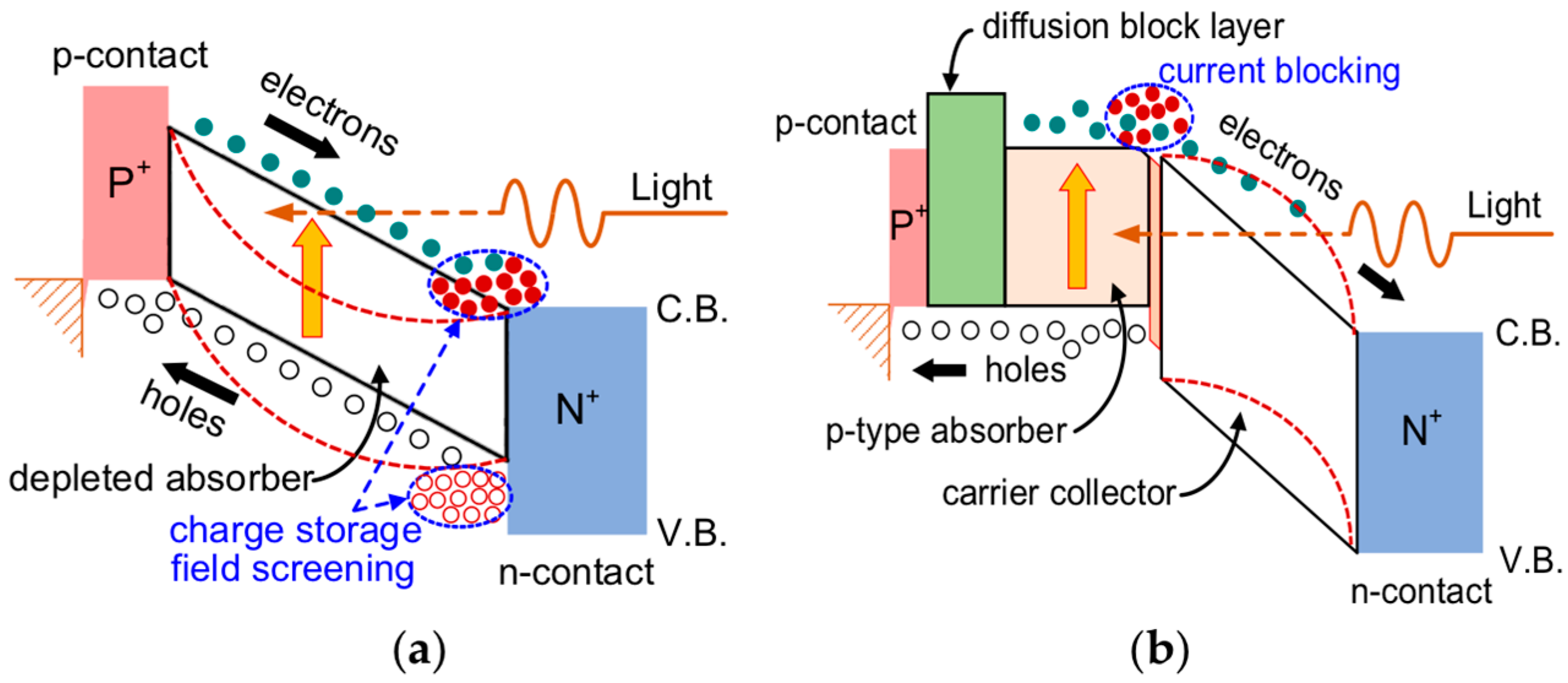
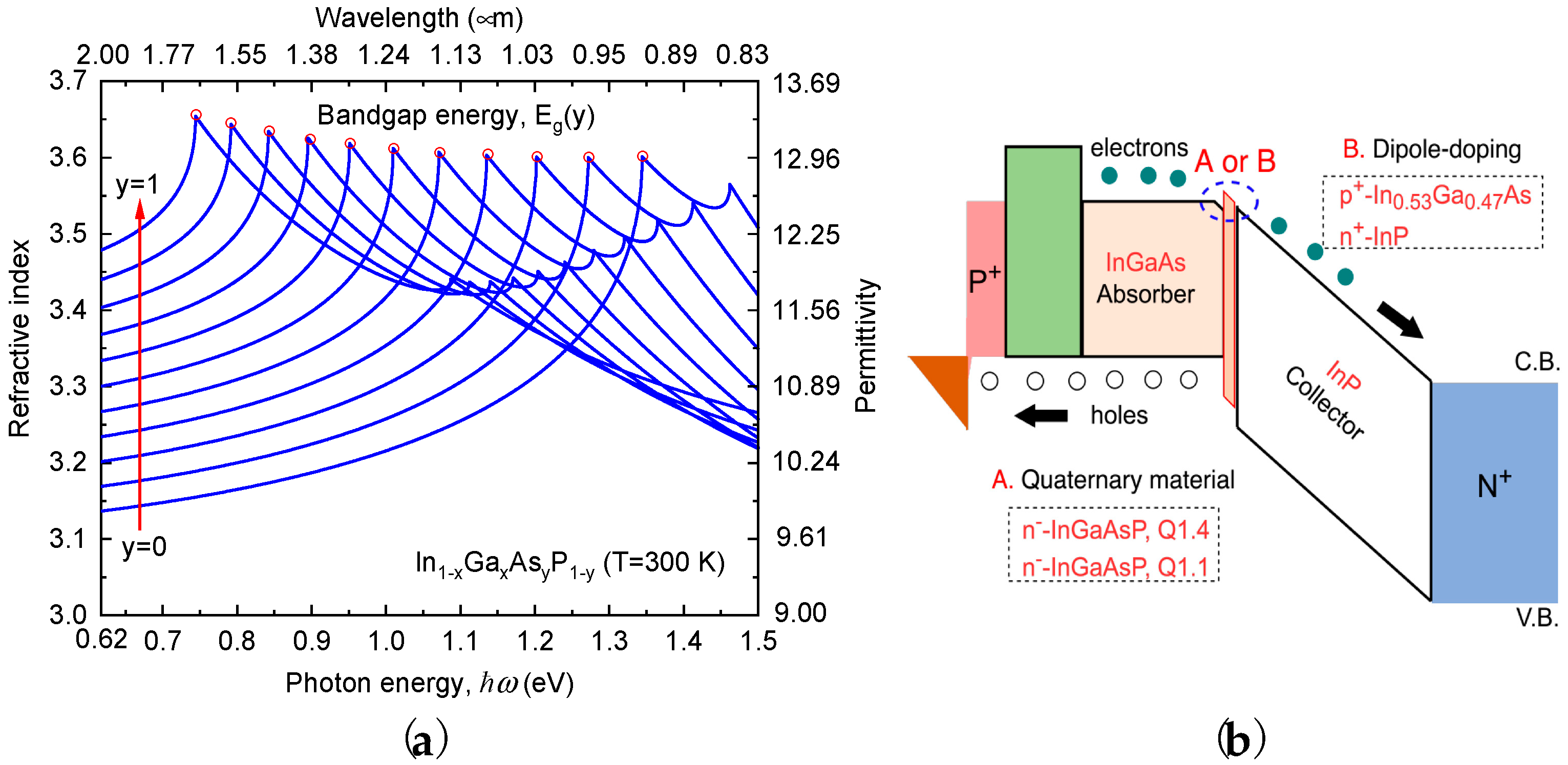

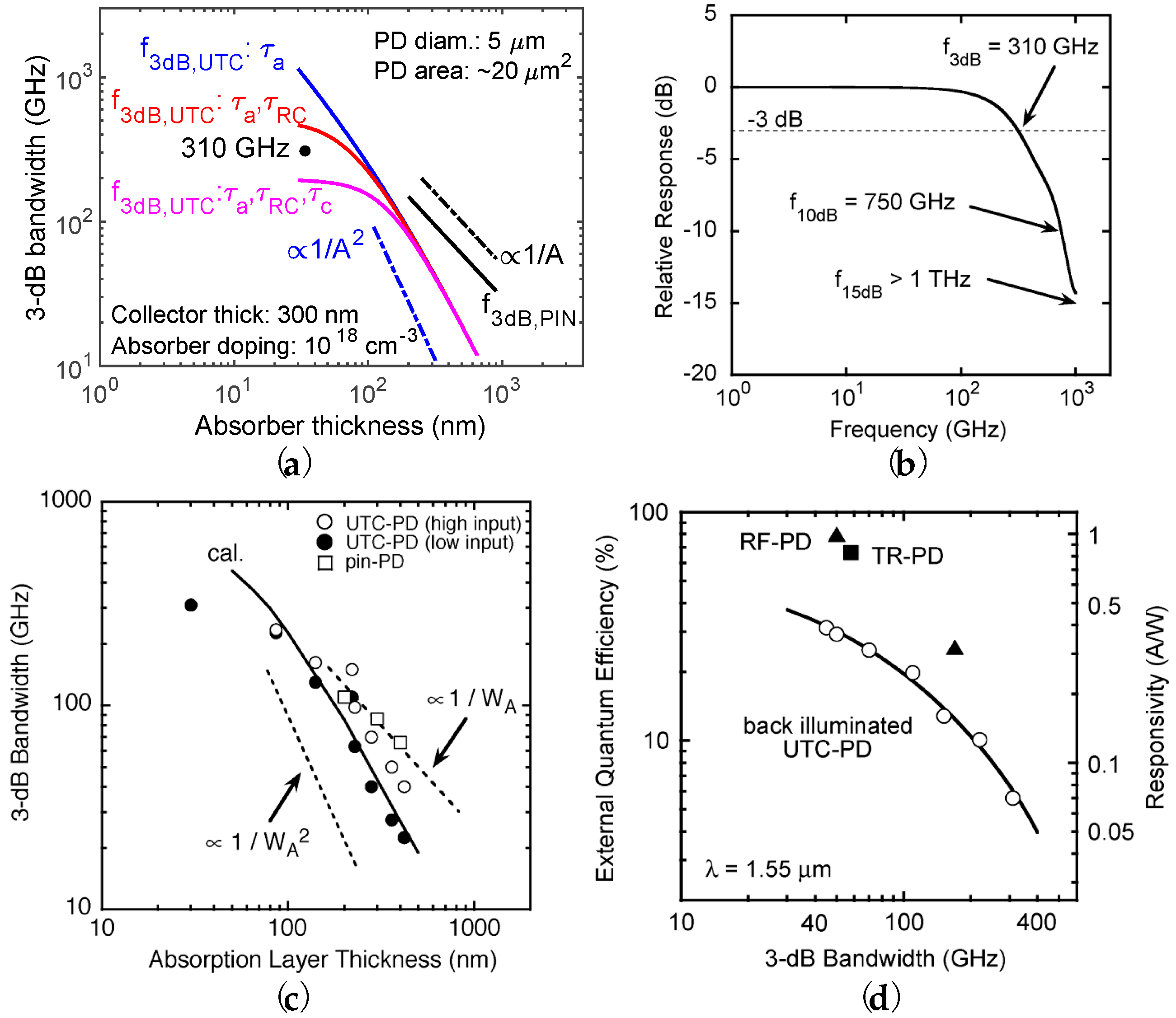
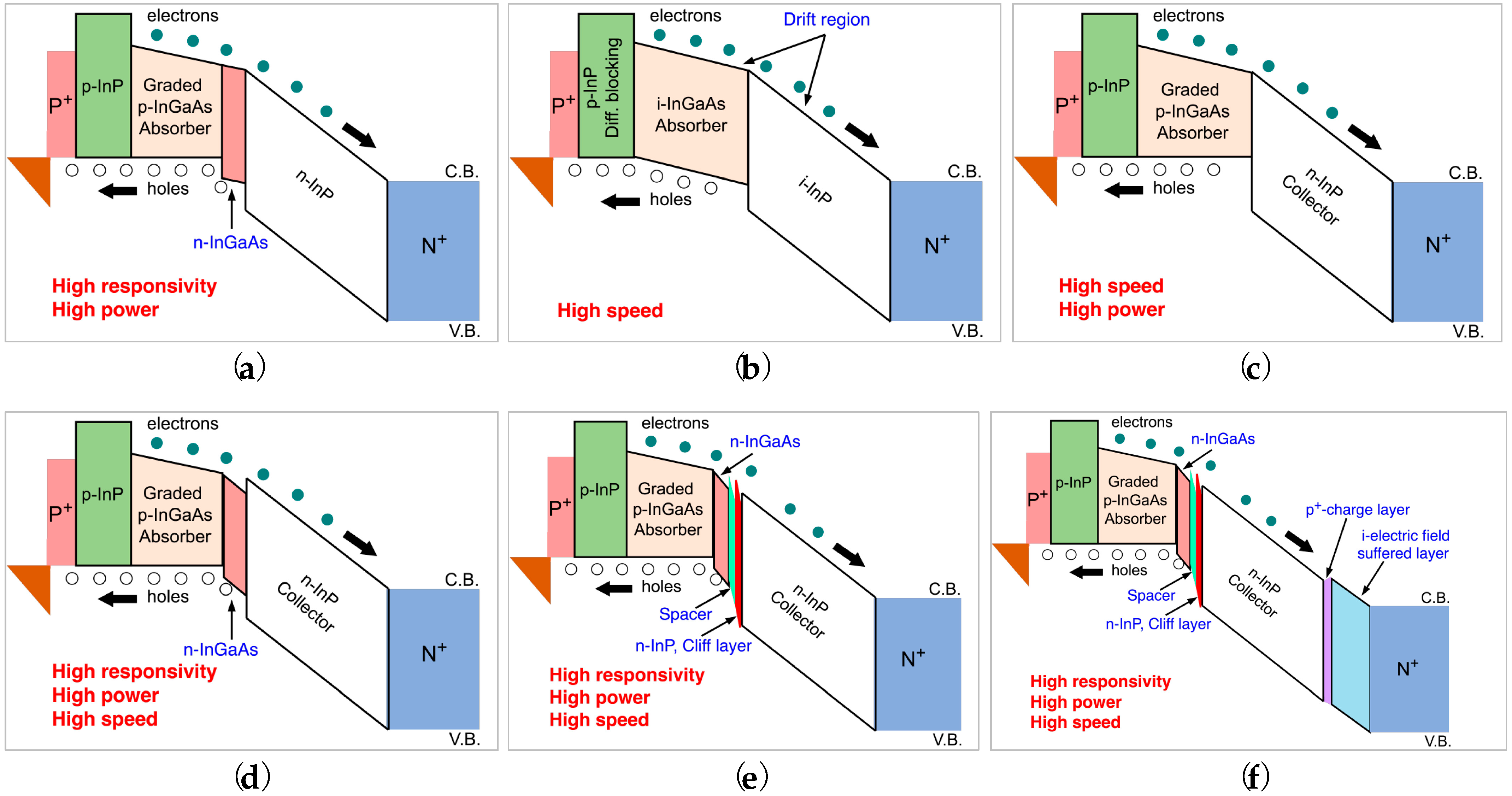




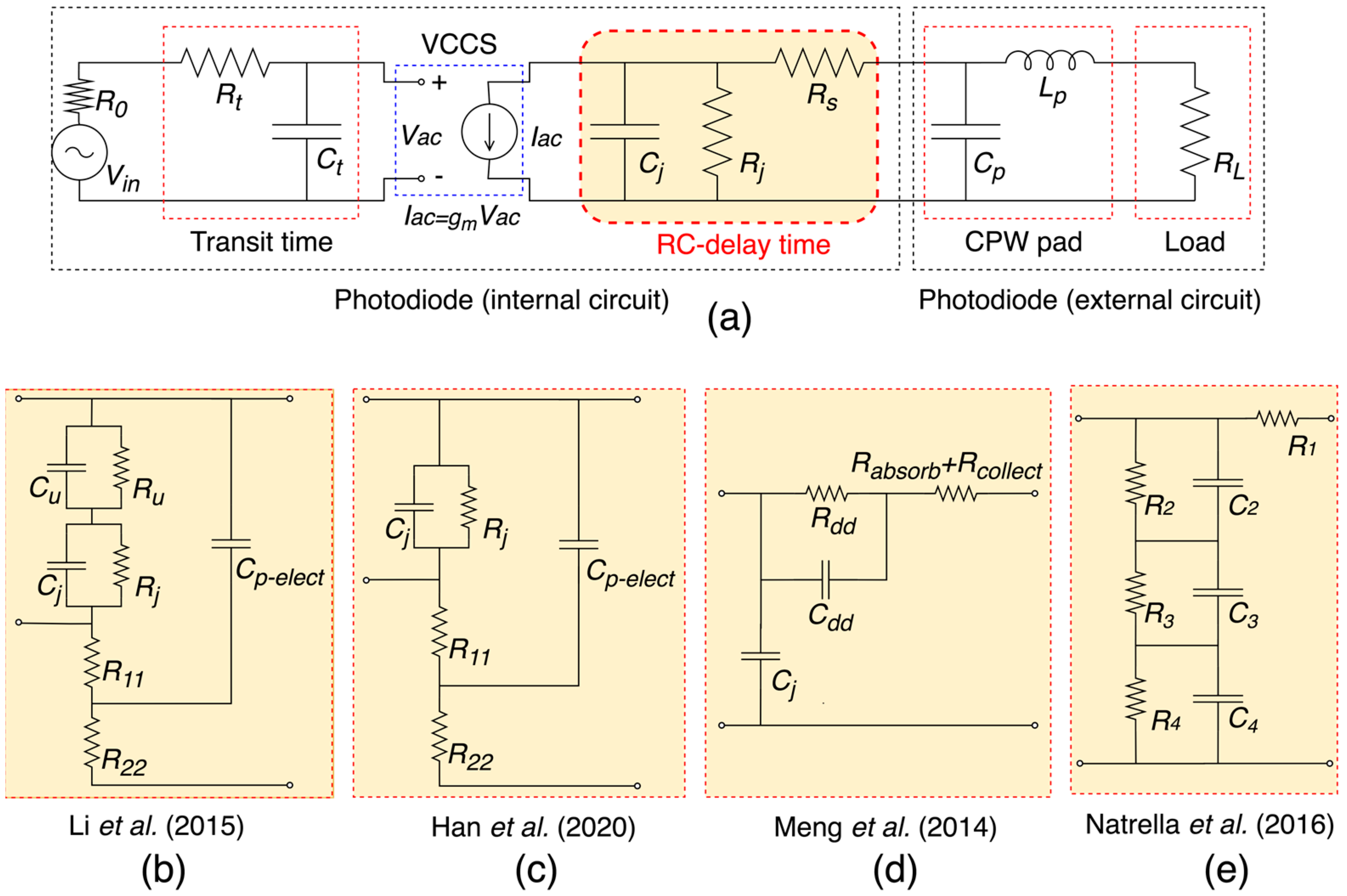


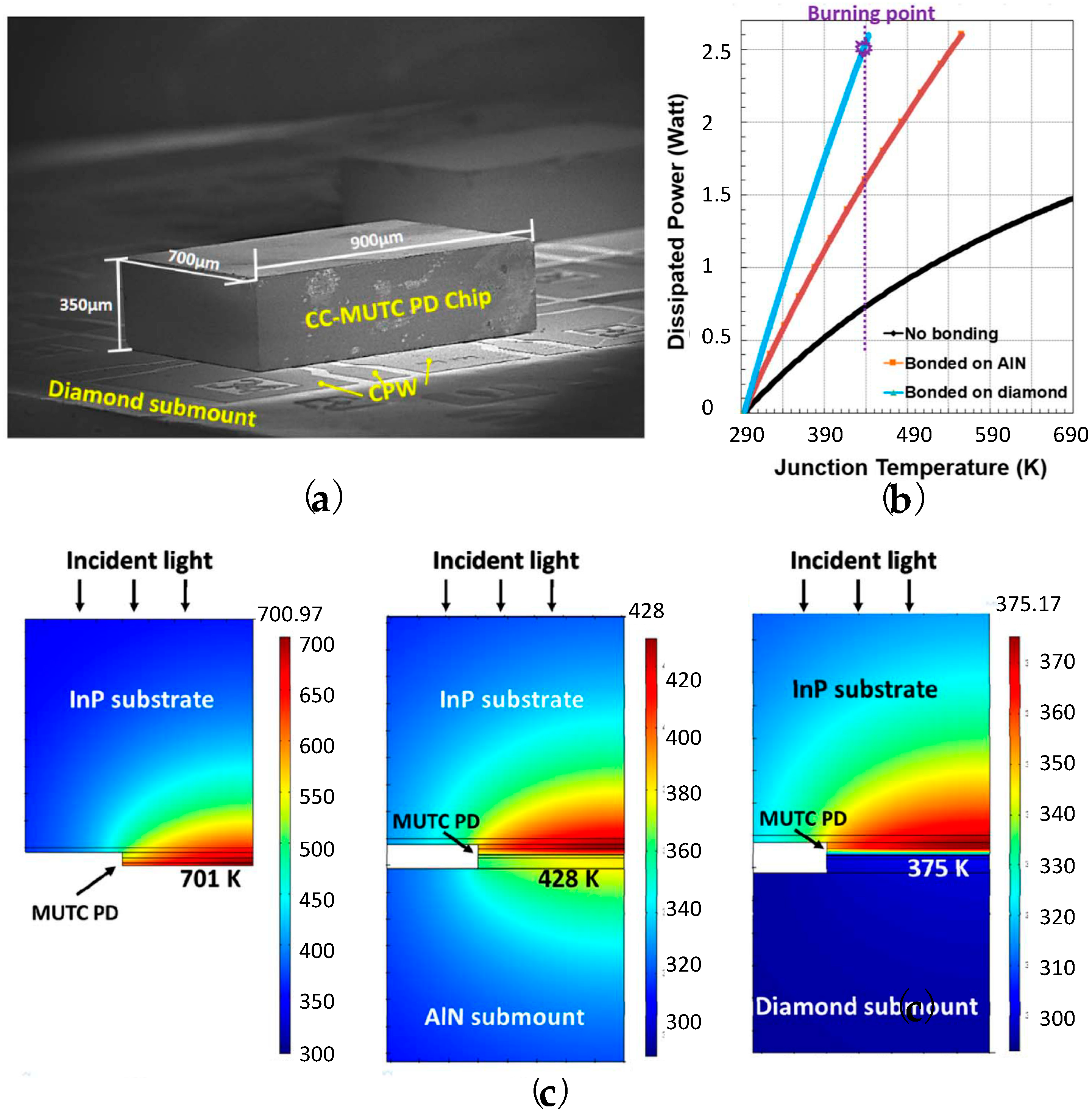
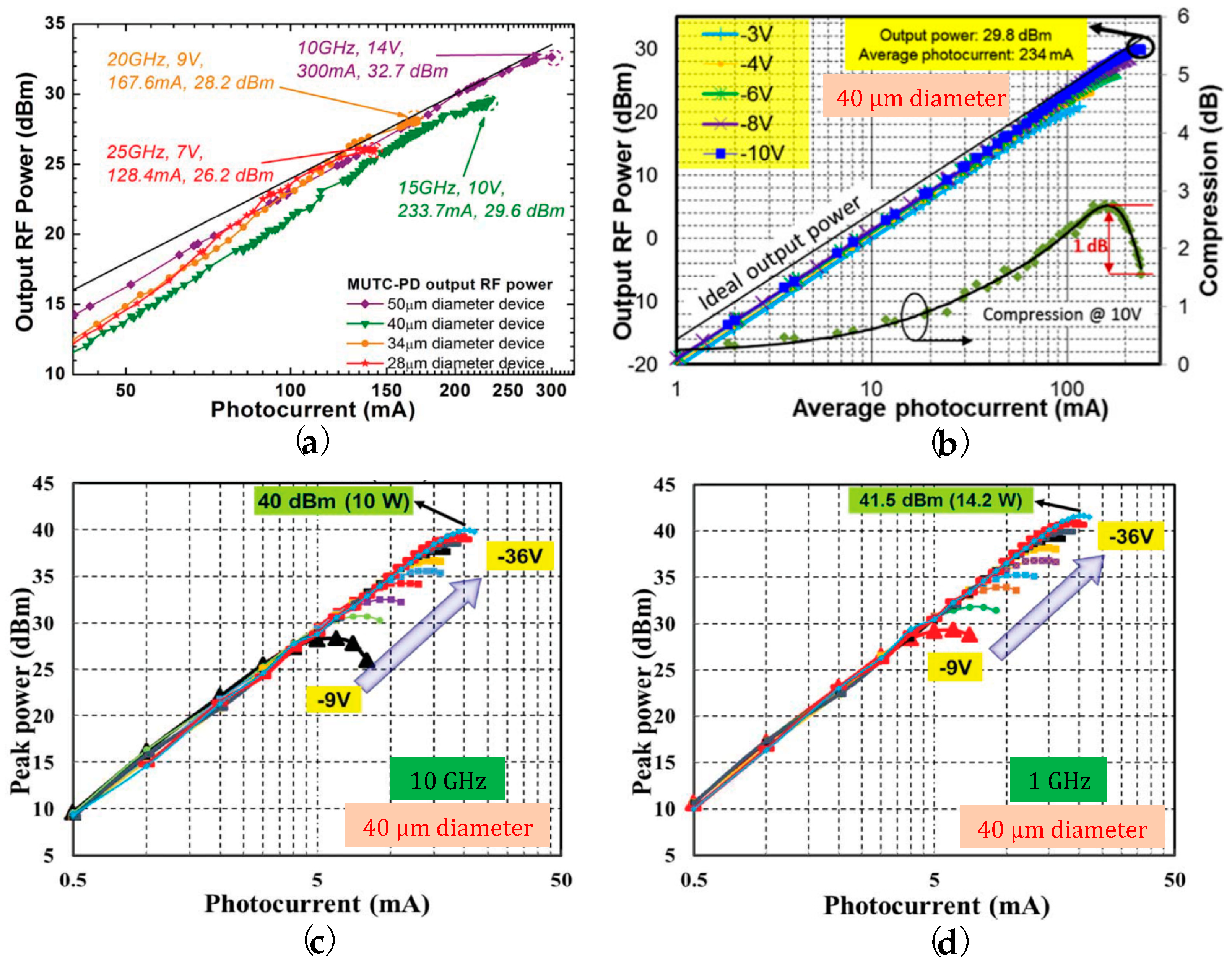


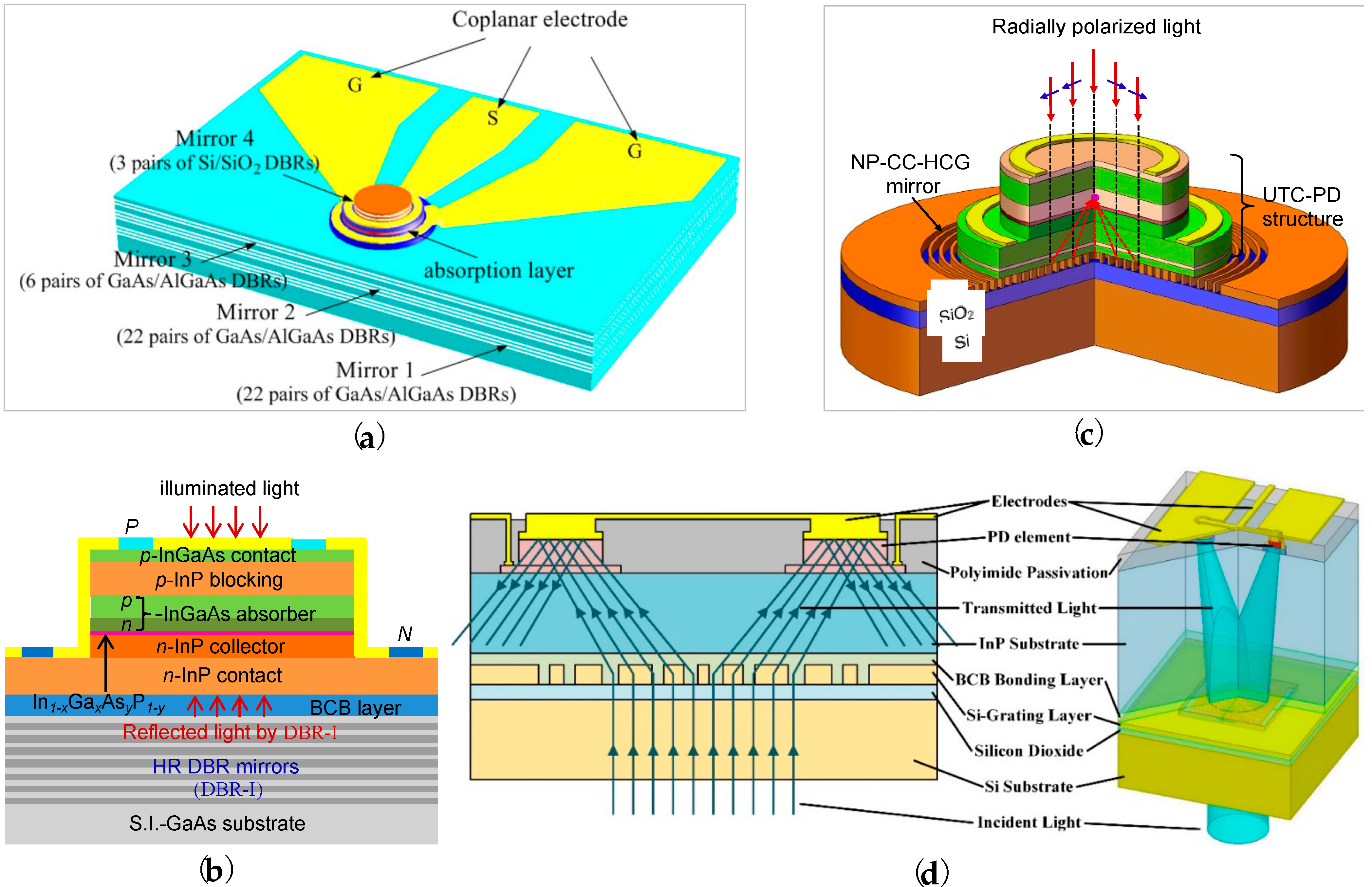

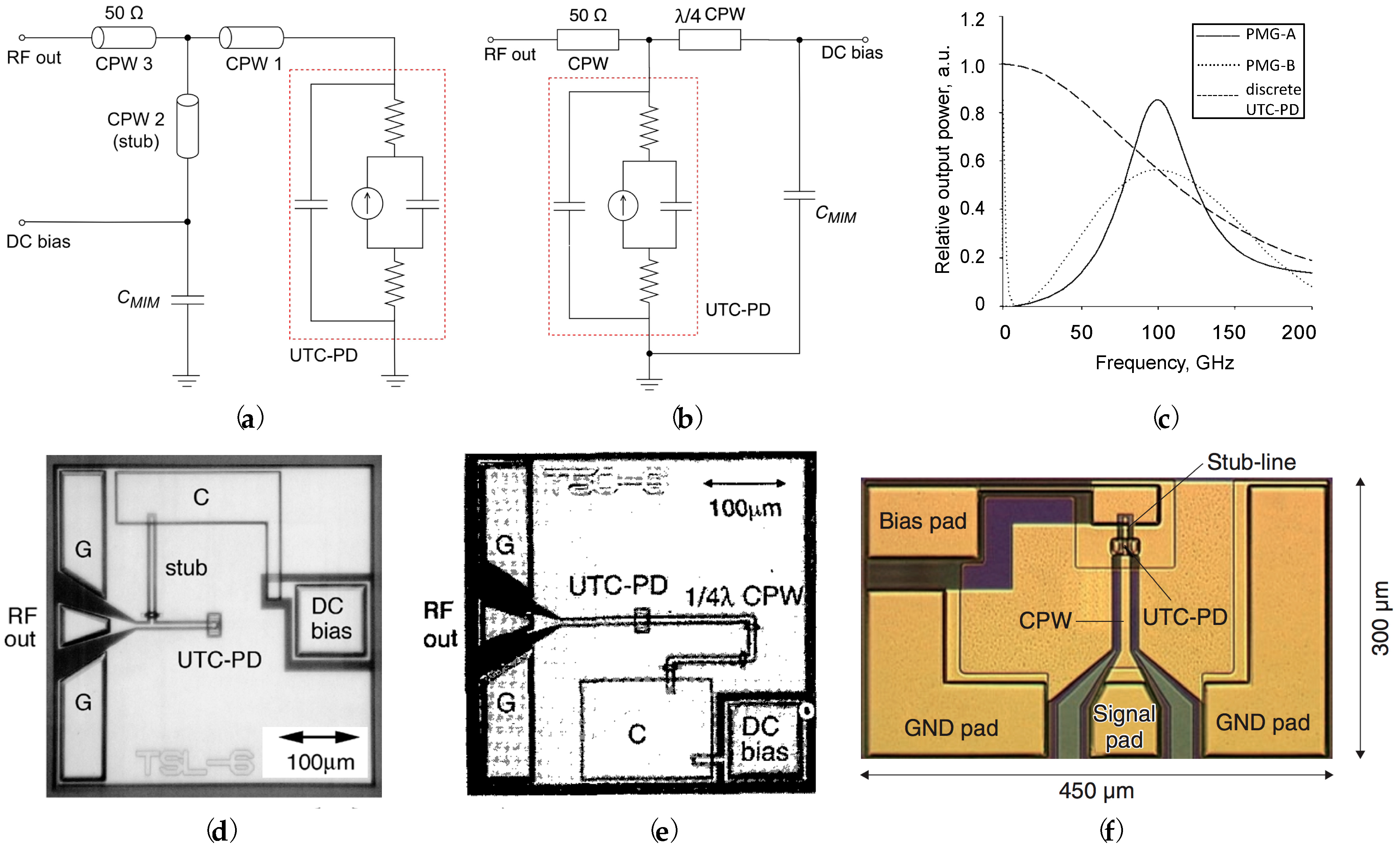


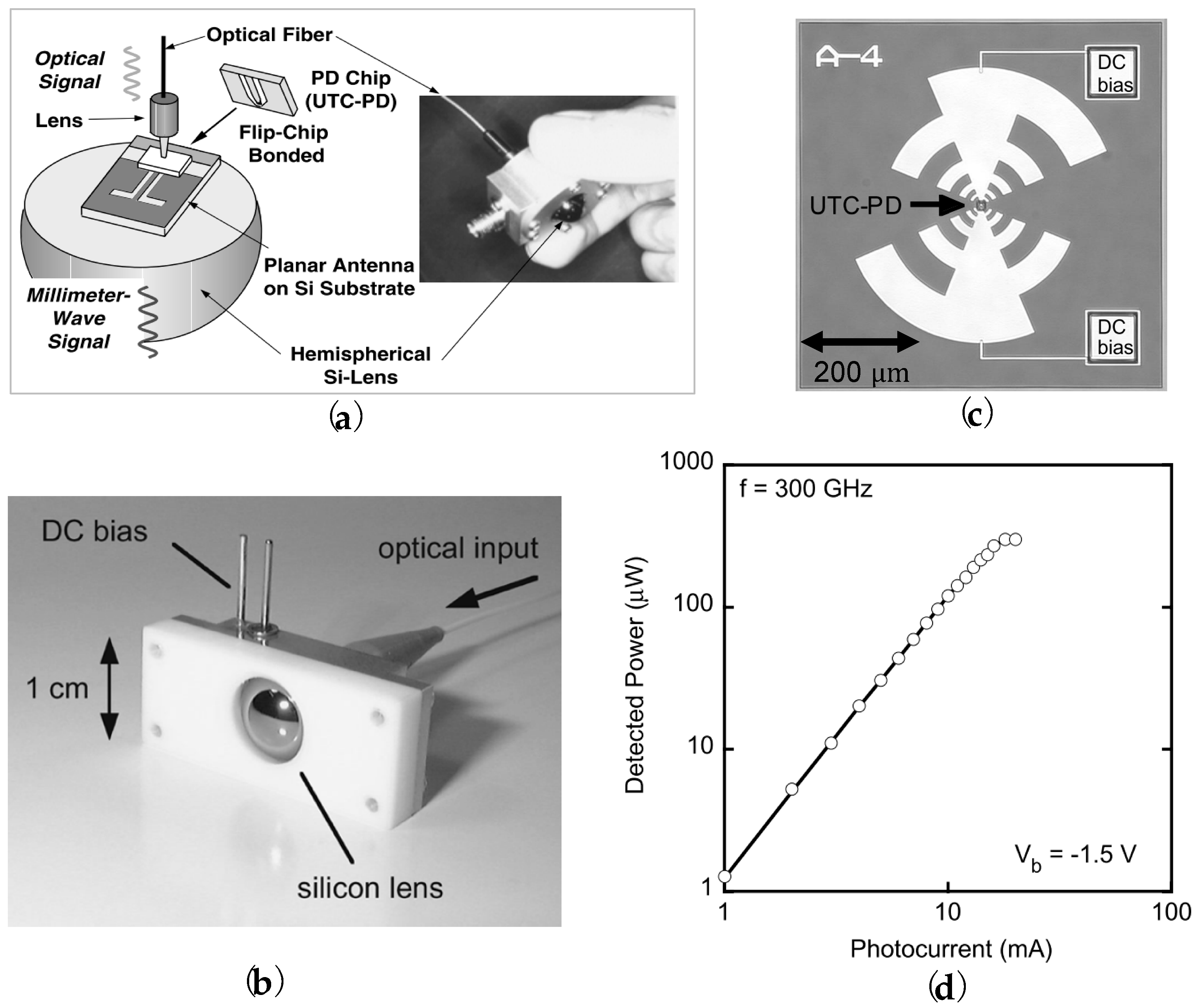
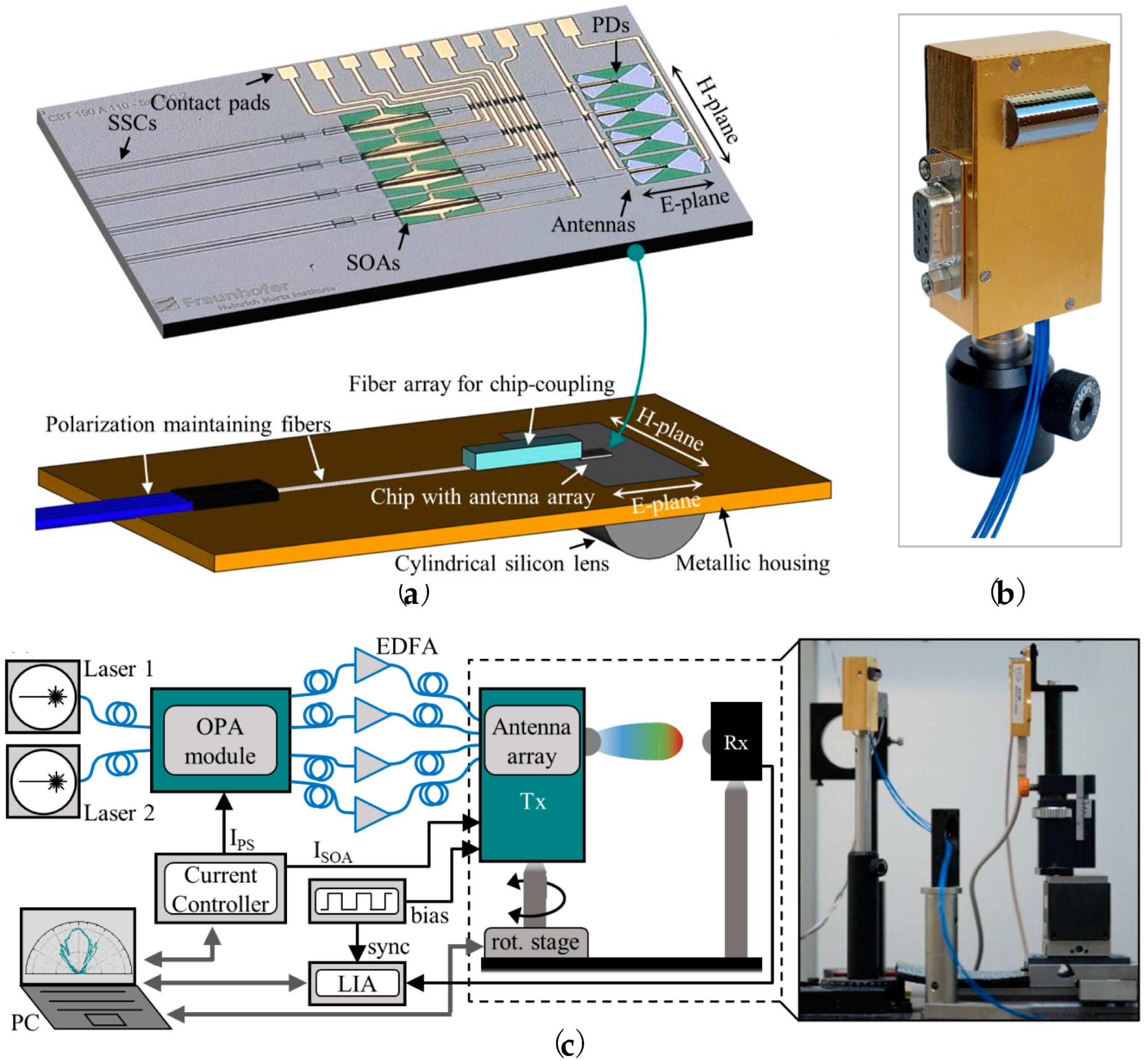
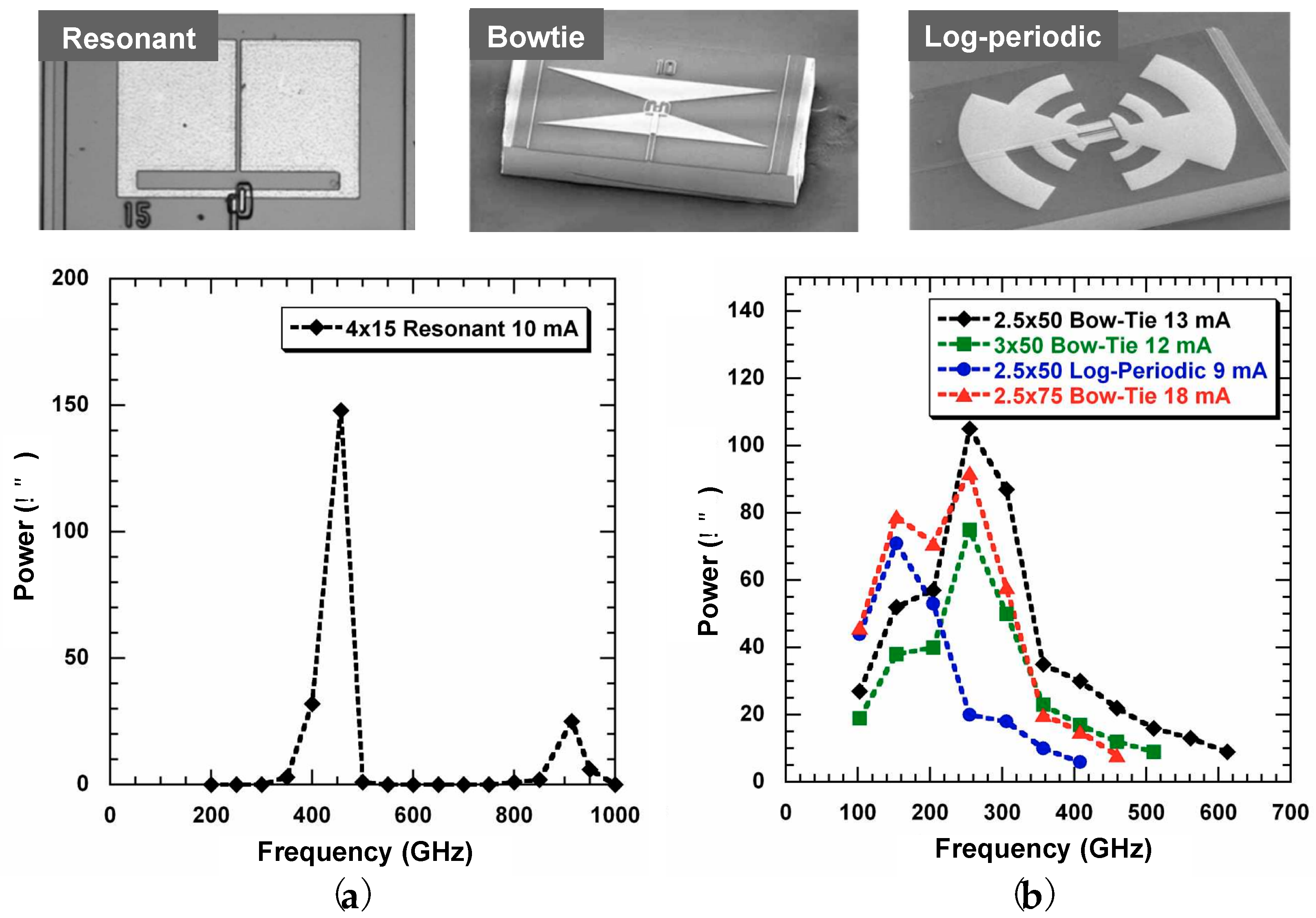

| Symbol | Value and Units | Explanations |
|---|---|---|
| Boltzmann constant | ||
| Electron charge | ||
| Temperature | ||
| Electron mass in vacuum | ||
| Electron mobility in p–InGaAs | ||
| 150 | Hole mobility in p–InGaAs | |
| Electron overshoot velocity in InGaAs and InP | ||
| Hole saturation velocity | ||
| Electron diffusion constant | ||
| Electron effective mass at the band edge | ||
| Thermionic–emission velocity | ||
| Electron drift velocity in absorber | ||
| Electron diffusion velocity in absorber | ||
| Carrier traveling time by electron diffusion | ||
| Electron drift time in collector | ||
| Boltzmann constant |
| PD Type * | BW (GHz) ** | R (A/W) | (mA) | Ref. | |
|---|---|---|---|---|---|
| UTC–PD | 310 | 0.07 | NA | 11 (12.59 mW) @ 100 GHz, −0.5 V | [67] |
| NBUTC–PD | 120 (64 μm2, −3.0 V) | 0.15 | 24.6 | 6.28 (4.25 mW) @ 110 GHz, −5 V | [94] |
| NBUTC–PD | 270 (3.5 μm, −3.0 V) | 0.12 | 17 | 6.12 (4.093 mW) @ 170 GHz, −2 V | [95,146] |
| NBUTC–PD | 225 (3 μm, −1.5 V) | 0.08 | 13 | −1.74 (0.67 mW) @ 260 GHz, −2 V | [97] |
| CC–MUTC–PD | >110 (4 μm) | 0.17 | 27 | 7.80 (6.03 mW) @ 110 GHz (6 μm), −4 V | [101] |
| MUTC–PD | 156 (4.5 μm, −3 V) | 0.165 | 14.6 | −0.53 (0.885 mW) @ 170 GHz, −3.5 V | [111] |
| MUTC–PD | 150 (4.5 μm, −3 V) | 0.165 | 14.6 | −0.16 (0.964 mW) @ 170 GHz, −3.5 V | [111] |
| MUTC–PD | 200 (3.6 μm) | 0.07 | 8.4 | −2.14 (0.611 mW) @ 200 GHz, −2 V | [113] |
| MUTC–PD | 230 (3 μm) | 0.07 | 5.85 | −4.94 (0.321 mW) @ 220 GHz, −2 V | [113] |
| CC–MUTC–PD | 105 (10 μm, −5.0 V) | 0.15 | >30 | 14 (25.12 mW) @ 80 GHz (10 μm), −2 V | [114] |
| CC–MUTC–PD | 117 (8 μm, −3.0 V) | 0.15 | >20 | 11.3 (13.49 mW) @ 100 GHz (8 μm), −2 V | [114] |
| CC–MUTC–PD | 117 (8 μm, −3.0 V) | 0.15 | >20 | 8.50 (7.08 mW) @ 110 GHz (8 μm), −2.5 V | [114] |
| CC–MUTC–PD | 150 (4 μm, −3.0 V) | 0.15 | 8.0 | ), −2.5 V | [114] |
| CC–MUTC–PD | , −1.1 V) | 0.11 | 4.9 | ), 0 V | [115] |
| CC–MUTC–PD | , −1.1 V) | 0.11 | 25.3 | ), −1.8 V | [115] |
| WG–MUTC–PD | −1.2 V) | 0.312 | 10.6 | –1.69 (0.678 mW) @ 215 GHz, −2 V | [119] |
| CC–MUTC–PD | ) | 0.2 | 40 | –2.60 (0.55 mW) @ 160 GHz, −5 V | [121] |
| CC–MUTC–PD | , −6 V) | 0.7 | 234 (−10 V) | 41.5 (14.2 W) @ 1 GHz, −36 V | [122] |
| CC–MUTC–PD | , −6 V) | 0.7 | 234 (−10 V) | 40 (10 W) @ 10 GHz, −36 V | [122] |
| CC–MUTC–PD | , −6 V) | 0.7 | 234 (−10 V) | 29.8 (0.955 W) @ 15 GHz, −10 V | [122] |
| UTC–PD | ) | NA | 21 | 0 (1 mW) @ 120 GHz, −3V | [123,124] |
| CC–MUTC–PD | ) | 0.75 | 300 | 32.7 (1.86 W) @ 10 GHz, −14 V | [130] |
| CC–MUTC–PD | ) | 0.75 | 228 | 30.1 (1.02 W) @ 10 GHz, −11 V | [131] |
| UTC–PD on SiC | NA | NA | 15.5 | 0.22 (1.05 mW) 300 GHz, −1 V | [134] |
| UTC–PD on SiC | NA | NA | 18 | 2.01 (1.59 mW) 300 GHz, bias optimized | [134] |
| PIN–PD | ) | NA | 620 | 26.5 (0.447 W) @ 1 GHz, −5 V | [136] |
| PIN–PD | ) | NA | 260 | 26 (0.398 W) @ 6 GHz, −5 V | [136] |
| PIN–PD | ) | 0.55 | 120 | 25.8 (0.38 W) @ 5 GHz | [137] |
| PIN–PD | ) | 0.6 | 200 | 29 (0.794 W) @ 5 GHz, −5.8 V | [138] |
| PIN–PD | ) | ~0.7 | 30 | 14 (25.12 mW) @ 50 GHz, −2 V | [139] |
| MUTC–PD array | ) | 0.438 | 86.8 | 16 (39.81 mW) @ 12 GHz, −3 V | [140] |
| MUTC–PD | −4 V) | 0.41 | ~70 | 17.1 (51.29 mW) @ 30 GHz, −4 V | [141] |
| MUTC–PD | −4 V) | 0.41 | 38 | 14.6 (28.84 mW) @ 40 GHz, −4 V | [141] |
| WG–UTC–PD | −3 V) | 0.19 | 13 | 1.1 (1.29 mW) @ 100 GHz, −3 V | [142] |
| TTR–UTC–PD | ) | 0.5 | 16 | 0 (1 mW) @ 110 GHz, −8 V | [143] |
| NBUTC–PD | , −3.0 V) | 0.15 | 13.6 | 1.85 (1.53 mW) @ 110 GHz, −3 V | [144] |
| NBUTC–PD | , −3.0 V) | 0.15 | 18 | 4.12 (2.58 mW) @ 110 GHz, −3 V | [144] |
| NBUTC–PD | , −3.0 V) | 0.15 | 29 | 8.10 (6.46 mW) @ 110 GHz, −3 V | [144] |
| NBUTC–PD | , −3.0 V) | 0.15 | 37 | 10.7 (11.75 mW) @ 110 GHz, −3 V | [144] |
| Type–II UTC–PD | , 0 V) | 0.09 | 8 | ) @ 160 GHz, 0 V | [145] |
| NBUTC–PD | , −0.5 V) | 0.1 | 13 | 0.174 (1.04 mW) @ 280 GHz, −1.2 V | [147,148] |
| RCE–UTC–PD | ) | 0.12 | 9.8 | –1.25 (0.75 mW) @ 300 GHz, −1 V | [149] |
| Two UTC–PD | 70 per PD | 0.17 | 20 | 0.79 (1.2 mW) @ 300 GHz, −3.9 V | [150] |
| Type–II UTC–PD | , −0.5 V) | 0.11 | 13 | –3 (0.5 mW) @ 320 GHz, −1 V | [151] |
| MUTC–PD | ~100 | 0.22 | 20 | –2.7 (0.54 mW) @ 350 GHz, −2.5 V | [152] |
| Device Type | Coupling Type | Si Lens | (mA) | Output Power (dBm) | Ref. |
|---|---|---|---|---|---|
| UTC–PD | WR10 port (W–band) | No | 25 | ) @ 100 GHz | [90] |
| UTC–PD | WR3 port (J–band) | No | 26 | ) @ 264 GHz | [190] |
| UTC–PD | WR8 port (F–band) | No | 25 | ) @ 120 GHz | [197,198] |
| UTC–PD | WR6 port (D–band) | No | 7 | ) @ 104~185 GHz | [200] |
| Coupler integrated UTC–PD | WR1.5 port | No | 9 | ) @ 500 GHz | [201] |
| Coupler integrated UTC–PD | WR1.5 port | No | 9 | ) @ 470~810 GHz | [201] |
| Coupler integrated UTC–PD | WR1.5 port | No | 6 | ) @ 500 GHz | [201] |
| Coupler integrated UTC–PD | WR1.5 port | No | 6 | ) @ 470~810 GHz | [201] |
| Device Type * | Coupling Type | Si Lens | (mA) | Output Power (dBm) | Ref. |
|---|---|---|---|---|---|
| NBUTC–PD | Yagi antenna | No | 30 | –14.1 (25.7 mW) @ 100 GHz | [18,223] |
| TW–UTC–PD | Log–periodic antenna | No | 9 | ) @ 150 GHz | [21] |
| TW–UTC–PD | Bowtie antenna | No | 13 | ) @ 255 GHz | [21] |
| TW–UTC–PD | Resonant antenna | No | 10 | ) @ 457 GHz | [21] |
| TW–UTC–PD | Bowtie antenna | No | 13 | ) @ 612 GHz | [21] |
| TW–UTC–PD | Resonant antenna | No | 10 | ) @ 914 GHz | [21] |
| CC–MUTC–PD | Log–periodic antenna | Yes | 7 | 9.9 (9.77 mW) @ 70 GHz | [22] |
| CC–MUTC–PD | Sinuous antenna | Yes | 7 | 11.5 (14.13 mW) @ 90 GHz | [22] |
| CC–MUTC–PD | Sinuous antenna | Yes | 20 | 20 (100 mW) @ 90 GHz | [22] |
| CC–MUTC–PD | Spiral antenna | Yes | 7 | 8.8 (7.59 mW) @ 100 GHz | [22] |
| MUTC–PD | Vivaldi antennas | No | 10 | 5 (3.2 mW) @ 110 GHz | [25] |
| Hybrid absorber UTC–PD | Bowtie antenna | Yes | 6 | ) @ 300 GHz | [72] |
| Hybrid absorber UTC–PD | Bowtie antenna | Yes | 6 | ) @ 1 THz | [72] |
| Hybrid absorber UTC–PD | Bowtie antenna | Yes | 6 | ) @ 1.5 THz | [72] |
| Hybrid absorber UTC–PD | Bowtie antenna | Yes | 6 | ) @ 2 THz | [72] |
| Hybrid absorber UTC–PD | Bowtie antenna | Yes | 6 | ) @ 2.5 THz | [72] |
| MUTC–PD | Patch antenna | No | 45 | 20 (100 mW) @ 60 GHz | [98] |
| TWPD | Bowtie antenna | Yes | 6.3 | ) @ 40 GHz | [91] |
| UTC–PD | Slot antenna | Yes | >20 | –5.23 (0.3 mW) @ 120 GHz | [123,124] |
| UTC–PD on SiC | Tapered slot antenna | No | 14.5 | 1.59 (1.44 mW) @ 273 GHz, −1 V | [134] |
| UTC–PD on SiC | Tapered slot antenna | No | 18 | 4.04 (2.53 mW) @ 273 GHz, bias optimized | [134] |
| WG–UTC–PD | Bowtie antenna | Yes | 13.5 | −12.22 (60 μW) @ 250 GHz | [142] |
| UTC–PD | Log–periodic antenna | Yes | 13 | −25.9 (2.6 μW) @ 1.04 THz | [204] |
| UTC–PD | Log–periodic antenna | Yes | 20 | −5.23 (300 μW) @ 300 GHz | [205] |
| PIN–PD array | Bowtie antenna | Yes | NA | >10 dB vs. an emitter @ 300 GHz | [206] |
| UTC–PD | Log–periodic antenna | Yes | 15 | −11.2 (75 μW) @ 414 GHz | [208] |
| UTC–PD | Log–periodic antenna | Yes | 15 | −17.4 (18 μW) @ 609 GHz | [208] |
| UTC–PD | Log–periodic antenna | Yes | 15 | −20.8 (8.3 μW) @ 804 GHz | [208] |
| UTC–PD | Twin dipole antenna | Yes | 14 | −19.6 (10.9 μW) @ 1.04 THz | [209] |
| UTC–PD | Log–periodic antenna | Yes | 20 | −9.2 (120 μW) @ 300 GHz | [224] |
| Type–II UTC–PD | Dual–ridge horn antenna | No | NA | −15 (31.6 μW) @ 240 GHz | [225] |
| UTC–PD | TEM–horn antenna | Yes | 2.75 | −29.5 (1.13 μW) @ 940 GHz | [226] |
| UTC–PD | TEM–horn antenna | Yes | 2.5 | −33.4 (0.46 μW) @ 1.04 THz | [226] |
| UTC–PD | TEM–horn antenna | Yes | 2.88 | −35.1 (0.31 μW) @ 1.365 THz | [226] |
| UTC–PD | slot antenna | Yes | 10 | −15.53 (28 μW) @ 700 GHz | [227] |
| UTC–PD | slot antenna | Yes | 10 | −24.56 (3.5 μW) @ 1.25 THz | [227] |
Disclaimer/Publisher’s Note: The statements, opinions and data contained in all publications are solely those of the individual author(s) and contributor(s) and not of MDPI and/or the editor(s). MDPI and/or the editor(s) disclaim responsibility for any injury to people or property resulting from any ideas, methods, instructions or products referred to in the content. |
© 2024 by the authors. Licensee MDPI, Basel, Switzerland. This article is an open access article distributed under the terms and conditions of the Creative Commons Attribution (CC BY) license (https://creativecommons.org/licenses/by/4.0/).
Share and Cite
Chen, Q.; Zhang, X.; Sharawi, M.S.; Kashyap, R. Advances in High–Speed, High–Power Photodiodes: From Fundamentals to Applications. Appl. Sci. 2024, 14, 3410. https://doi.org/10.3390/app14083410
Chen Q, Zhang X, Sharawi MS, Kashyap R. Advances in High–Speed, High–Power Photodiodes: From Fundamentals to Applications. Applied Sciences. 2024; 14(8):3410. https://doi.org/10.3390/app14083410
Chicago/Turabian StyleChen, Qingtao, Xiupu Zhang, Mohammad S. Sharawi, and Raman Kashyap. 2024. "Advances in High–Speed, High–Power Photodiodes: From Fundamentals to Applications" Applied Sciences 14, no. 8: 3410. https://doi.org/10.3390/app14083410








